Quick filters:
Tadpole with four legs Stock Photos and Images
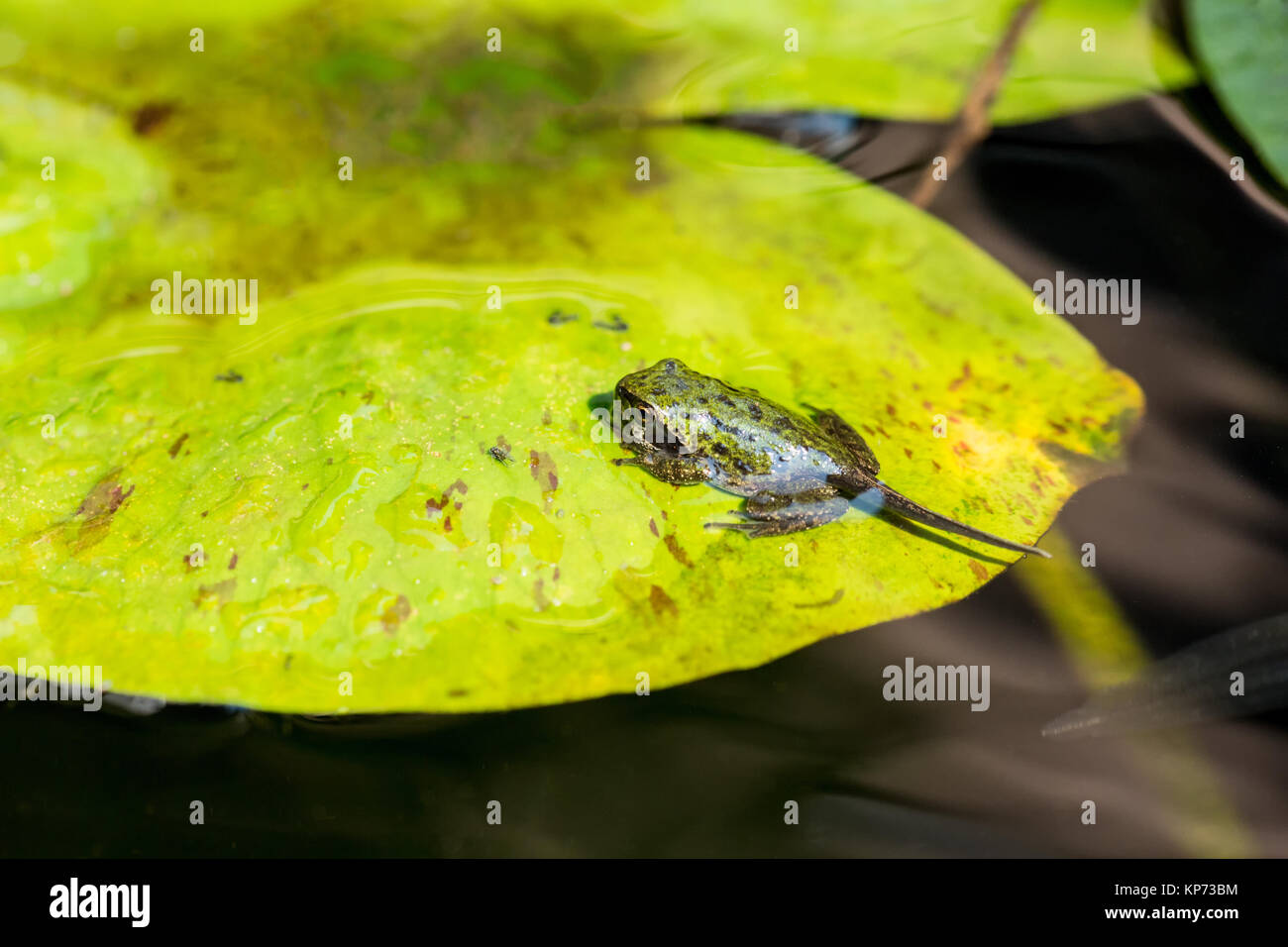 Pacific Tree Frog or Pacific Chorus Frog (Pseudacris regilla) in the tadpole with four legs stage, resting on a water lily pad in a pond in Issaquah, Stock Photohttps://www.alamy.com/image-license-details/?v=1https://www.alamy.com/stock-image-pacific-tree-frog-or-pacific-chorus-frog-pseudacris-regilla-in-the-168572088.html
Pacific Tree Frog or Pacific Chorus Frog (Pseudacris regilla) in the tadpole with four legs stage, resting on a water lily pad in a pond in Issaquah, Stock Photohttps://www.alamy.com/image-license-details/?v=1https://www.alamy.com/stock-image-pacific-tree-frog-or-pacific-chorus-frog-pseudacris-regilla-in-the-168572088.htmlRFKP73BM–Pacific Tree Frog or Pacific Chorus Frog (Pseudacris regilla) in the tadpole with four legs stage, resting on a water lily pad in a pond in Issaquah,
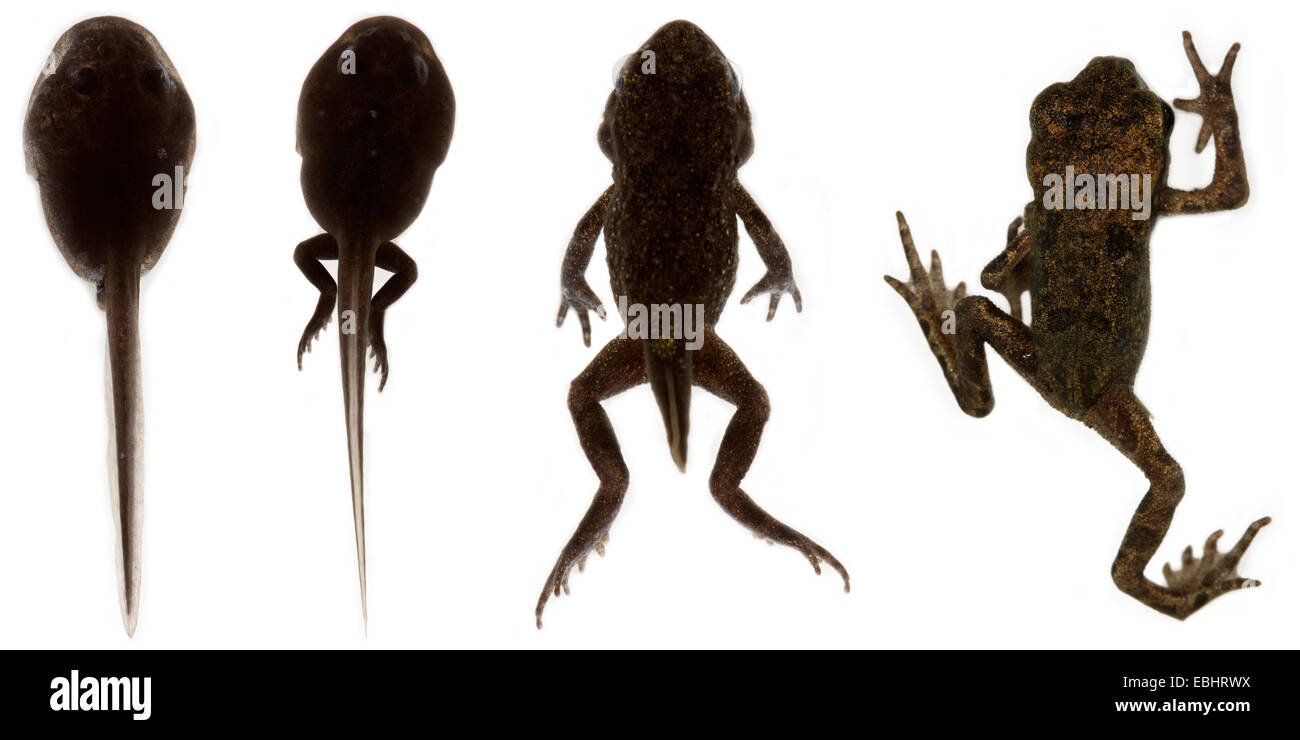 Four images showing the transformation from a tadpole to a frog, on white background. Stock Photohttps://www.alamy.com/image-license-details/?v=1https://www.alamy.com/stock-photo-four-images-showing-the-transformation-from-a-tadpole-to-a-frog-on-75994630.html
Four images showing the transformation from a tadpole to a frog, on white background. Stock Photohttps://www.alamy.com/image-license-details/?v=1https://www.alamy.com/stock-photo-four-images-showing-the-transformation-from-a-tadpole-to-a-frog-on-75994630.htmlRMEBHRWX–Four images showing the transformation from a tadpole to a frog, on white background.
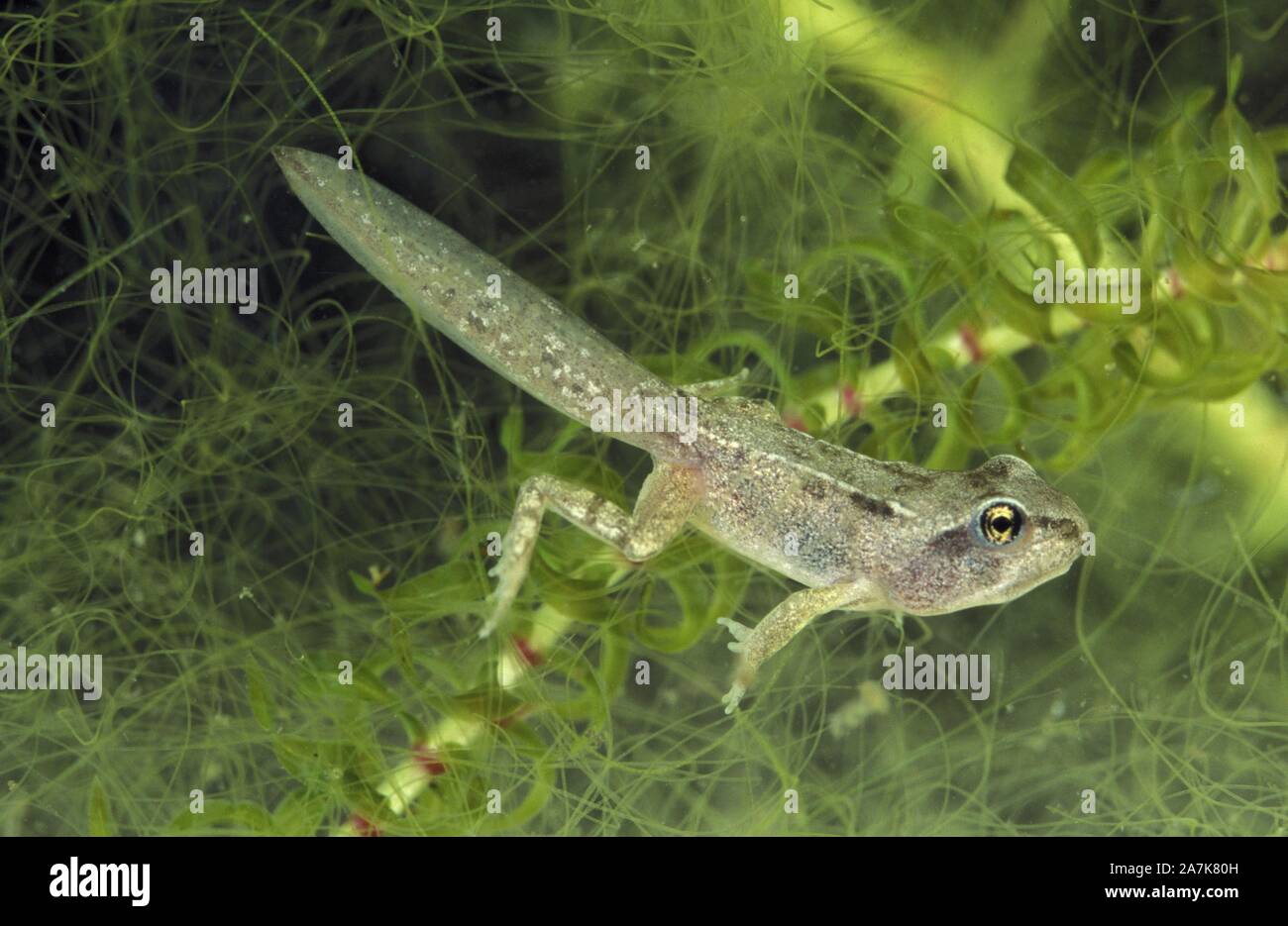 Common frog (Rana temporaria) almost a young frog (1 cm length) with four legs - the tadpole will still lose its tail to become frog - Underwater view Stock Photohttps://www.alamy.com/image-license-details/?v=1https://www.alamy.com/common-frog-rana-temporaria-almost-a-young-frog-1-cm-length-with-four-legs-the-tadpole-will-still-lose-its-tail-to-become-frog-underwater-view-image331722961.html
Common frog (Rana temporaria) almost a young frog (1 cm length) with four legs - the tadpole will still lose its tail to become frog - Underwater view Stock Photohttps://www.alamy.com/image-license-details/?v=1https://www.alamy.com/common-frog-rana-temporaria-almost-a-young-frog-1-cm-length-with-four-legs-the-tadpole-will-still-lose-its-tail-to-become-frog-underwater-view-image331722961.htmlRM2A7K80H–Common frog (Rana temporaria) almost a young frog (1 cm length) with four legs - the tadpole will still lose its tail to become frog - Underwater view
 France, Isere, French Haut Rhone Nature Reserve, Yellow bellied Ringer Tadpole (Bombina variegata), last stage, tail and four legs, alluvial forest rut Stock Photohttps://www.alamy.com/image-license-details/?v=1https://www.alamy.com/france-isere-french-haut-rhone-nature-reserve-yellow-bellied-ringer-tadpole-bombina-variegata-last-stage-tail-and-four-legs-alluvial-forest-rut-image545992576.html
France, Isere, French Haut Rhone Nature Reserve, Yellow bellied Ringer Tadpole (Bombina variegata), last stage, tail and four legs, alluvial forest rut Stock Photohttps://www.alamy.com/image-license-details/?v=1https://www.alamy.com/france-isere-french-haut-rhone-nature-reserve-yellow-bellied-ringer-tadpole-bombina-variegata-last-stage-tail-and-four-legs-alluvial-forest-rut-image545992576.htmlRM2PM832T–France, Isere, French Haut Rhone Nature Reserve, Yellow bellied Ringer Tadpole (Bombina variegata), last stage, tail and four legs, alluvial forest rut
 Tadpole with four legs still breathing water - Osteopilus septentrionalis Stock Photohttps://www.alamy.com/image-license-details/?v=1https://www.alamy.com/stock-photo-tadpole-with-four-legs-still-breathing-water-osteopilus-septentrionalis-108464024.html
Tadpole with four legs still breathing water - Osteopilus septentrionalis Stock Photohttps://www.alamy.com/image-license-details/?v=1https://www.alamy.com/stock-photo-tadpole-with-four-legs-still-breathing-water-osteopilus-septentrionalis-108464024.htmlRFG8CXY4–Tadpole with four legs still breathing water - Osteopilus septentrionalis
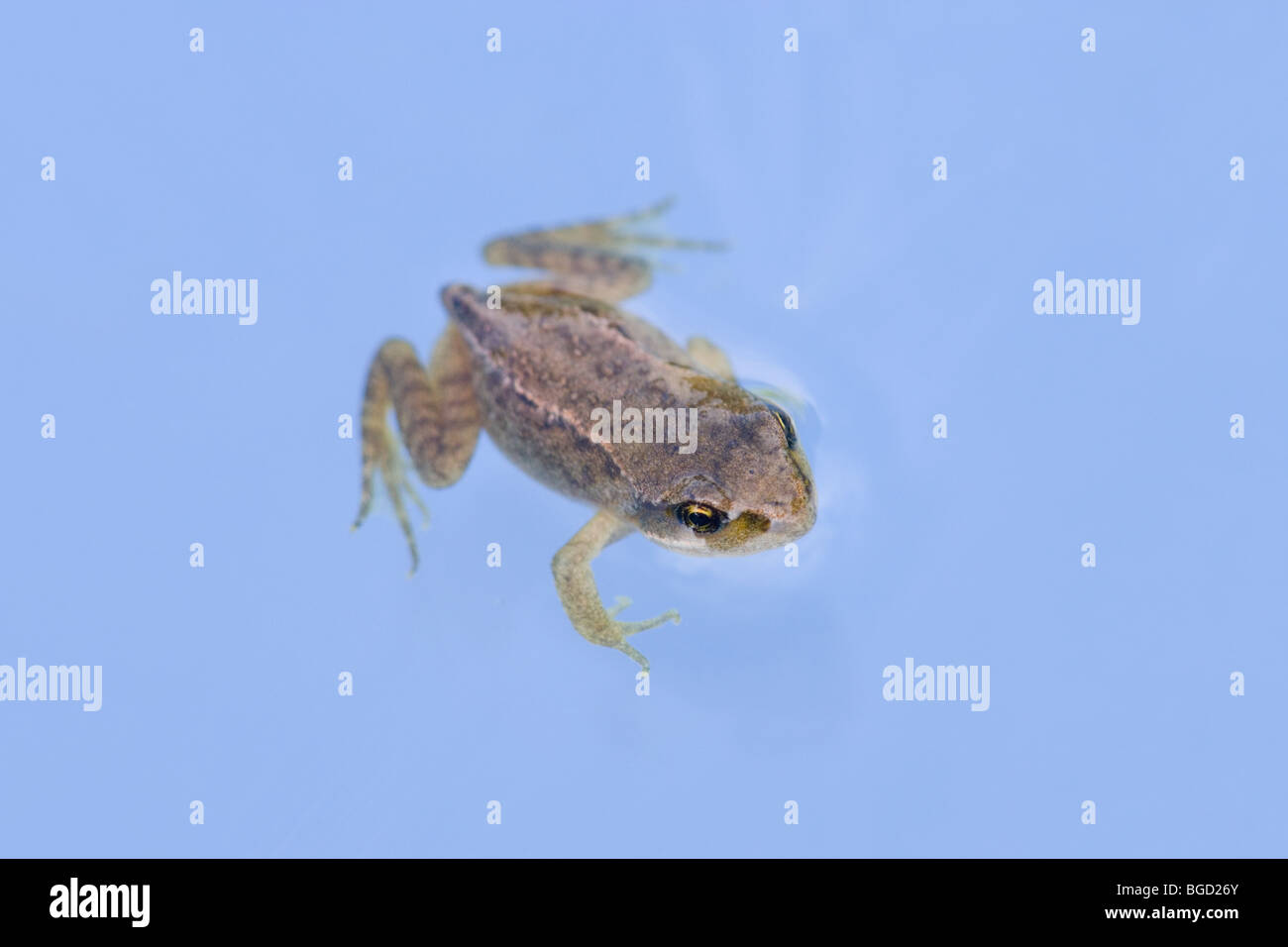 Common Frog (Rana temporaria). Metamorphosis. Developmental stage from tadpole. All four legs. Tail regression or absorption. Stock Photohttps://www.alamy.com/image-license-details/?v=1https://www.alamy.com/stock-photo-common-frog-rana-temporaria-metamorphosis-developmental-stage-from-27332003.html
Common Frog (Rana temporaria). Metamorphosis. Developmental stage from tadpole. All four legs. Tail regression or absorption. Stock Photohttps://www.alamy.com/image-license-details/?v=1https://www.alamy.com/stock-photo-common-frog-rana-temporaria-metamorphosis-developmental-stage-from-27332003.htmlRMBGD26Y–Common Frog (Rana temporaria). Metamorphosis. Developmental stage from tadpole. All four legs. Tail regression or absorption.
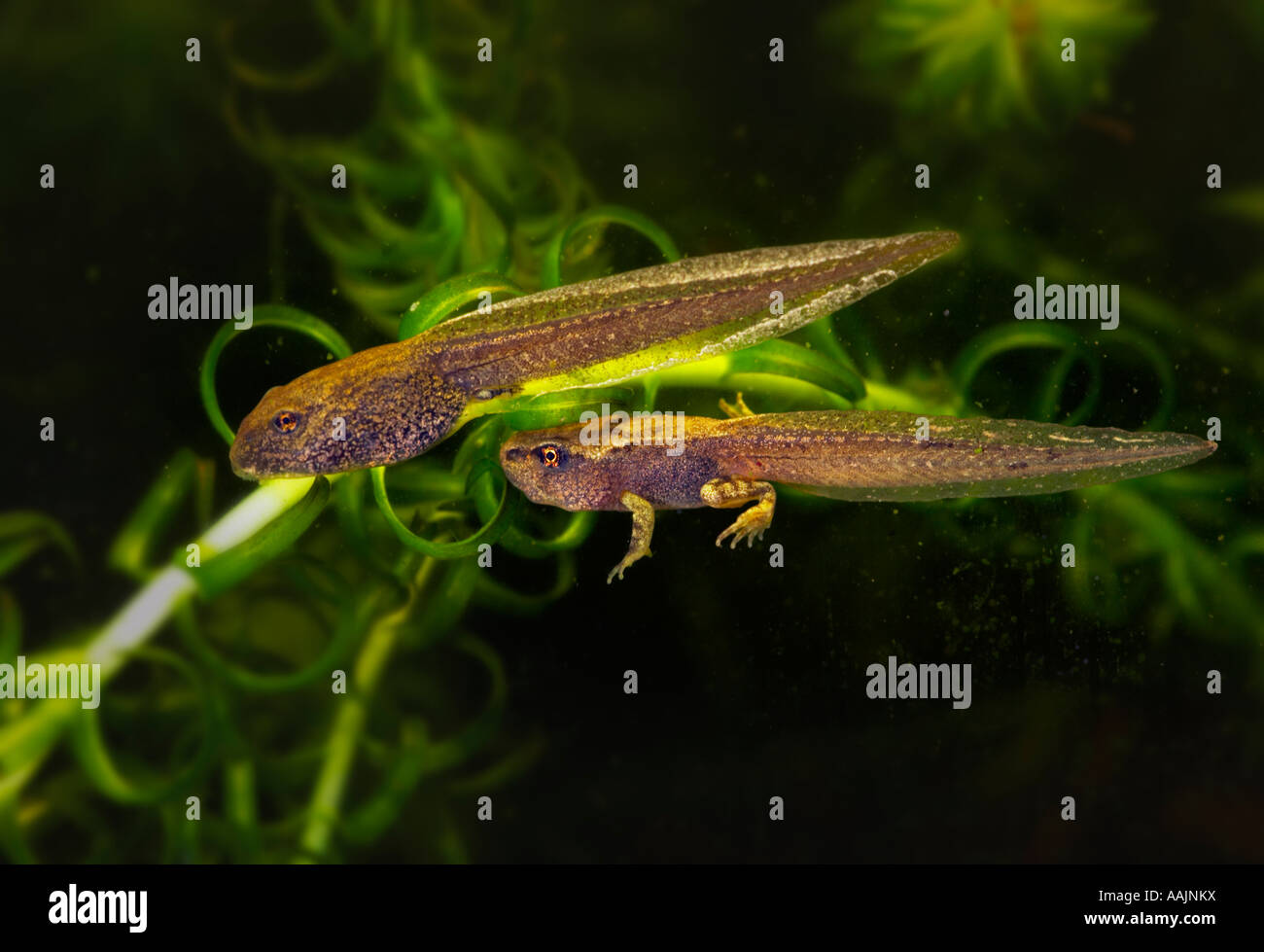 Tadpole with four legs and one with none swimming Stock Photohttps://www.alamy.com/image-license-details/?v=1https://www.alamy.com/stock-photo-tadpole-with-four-legs-and-one-with-none-swimming-12645373.html
Tadpole with four legs and one with none swimming Stock Photohttps://www.alamy.com/image-license-details/?v=1https://www.alamy.com/stock-photo-tadpole-with-four-legs-and-one-with-none-swimming-12645373.htmlRMAAJNKX–Tadpole with four legs and one with none swimming
 COMMON FROG (Rana temporaria). 'Froglet' with almost total absorption of tail seen in last tadpole stages of development. Stock Photohttps://www.alamy.com/image-license-details/?v=1https://www.alamy.com/common-frog-rana-temporaria-froglet-with-almost-total-absorption-of-tail-seen-in-last-tadpole-stages-of-development-image338839971.html
COMMON FROG (Rana temporaria). 'Froglet' with almost total absorption of tail seen in last tadpole stages of development. Stock Photohttps://www.alamy.com/image-license-details/?v=1https://www.alamy.com/common-frog-rana-temporaria-froglet-with-almost-total-absorption-of-tail-seen-in-last-tadpole-stages-of-development-image338839971.htmlRM2AK7DRF–COMMON FROG (Rana temporaria). 'Froglet' with almost total absorption of tail seen in last tadpole stages of development.
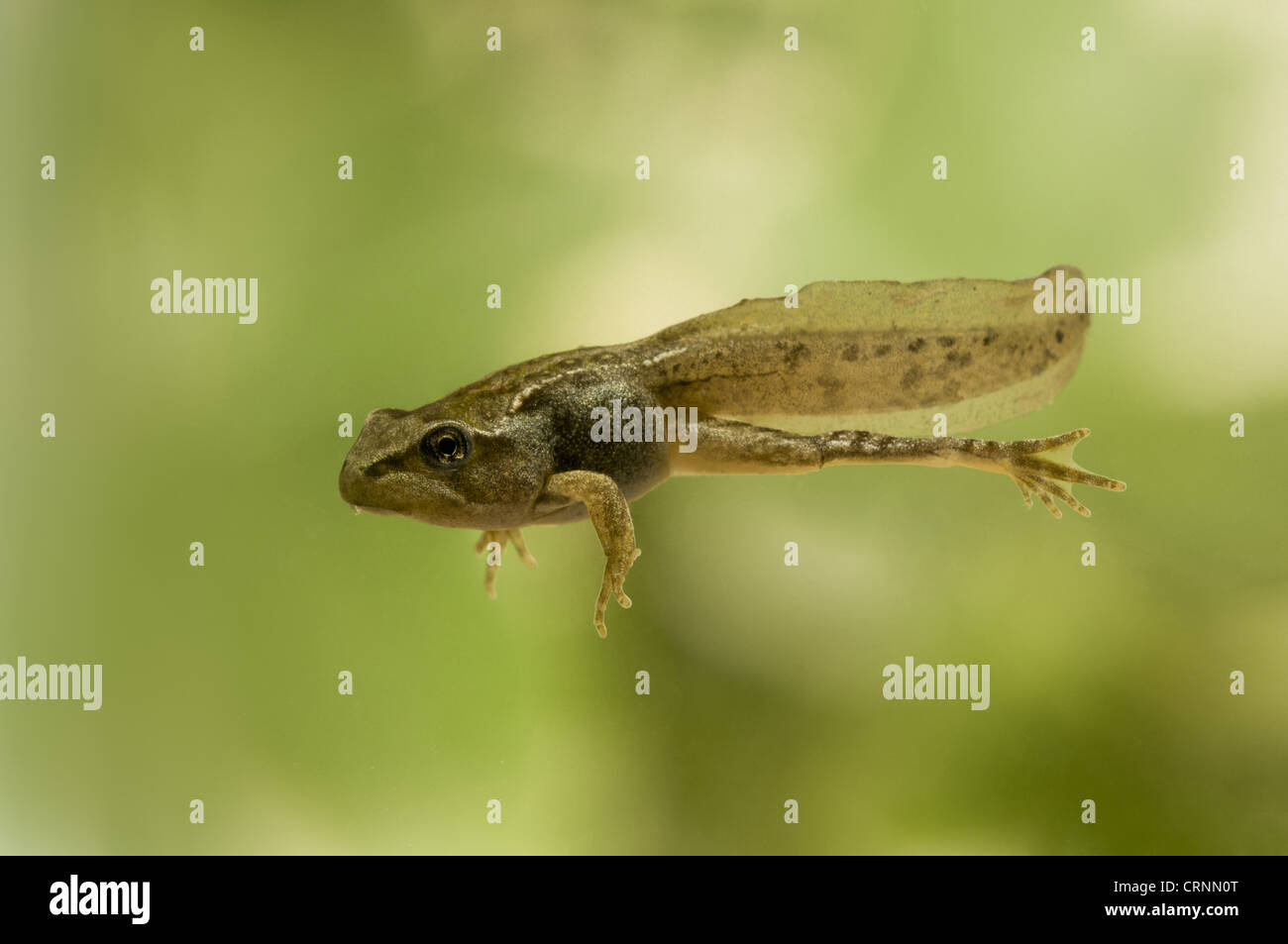 Common Frog (Rana temporaria) tadpole, partial metamorphosis with all four legs present but still retaining tail, swimming Stock Photohttps://www.alamy.com/image-license-details/?v=1https://www.alamy.com/stock-photo-common-frog-rana-temporaria-tadpole-partial-metamorphosis-with-all-49035304.html
Common Frog (Rana temporaria) tadpole, partial metamorphosis with all four legs present but still retaining tail, swimming Stock Photohttps://www.alamy.com/image-license-details/?v=1https://www.alamy.com/stock-photo-common-frog-rana-temporaria-tadpole-partial-metamorphosis-with-all-49035304.htmlRMCRNN0T–Common Frog (Rana temporaria) tadpole, partial metamorphosis with all four legs present but still retaining tail, swimming
 Common Frog (Rana temporaria). Metamorphosis; developmental stage from tadpole to frog. Full length tail. Four legs. Stock Photohttps://www.alamy.com/image-license-details/?v=1https://www.alamy.com/stock-photo-common-frog-rana-temporaria-metamorphosis-developmental-stage-from-27332060.html
Common Frog (Rana temporaria). Metamorphosis; developmental stage from tadpole to frog. Full length tail. Four legs. Stock Photohttps://www.alamy.com/image-license-details/?v=1https://www.alamy.com/stock-photo-common-frog-rana-temporaria-metamorphosis-developmental-stage-from-27332060.htmlRMBGD290–Common Frog (Rana temporaria). Metamorphosis; developmental stage from tadpole to frog. Full length tail. Four legs.
 A small toad tadpole, on a stone, has almost completed its metamorphosis: you can see the head, eyes, tail and four legs. The skin is moist and clammy Stock Photohttps://www.alamy.com/image-license-details/?v=1https://www.alamy.com/a-small-toad-tadpole-on-a-stone-has-almost-completed-its-metamorphosis-you-can-see-the-head-eyes-tail-and-four-legs-the-skin-is-moist-and-clammy-image611716211.html
A small toad tadpole, on a stone, has almost completed its metamorphosis: you can see the head, eyes, tail and four legs. The skin is moist and clammy Stock Photohttps://www.alamy.com/image-license-details/?v=1https://www.alamy.com/a-small-toad-tadpole-on-a-stone-has-almost-completed-its-metamorphosis-you-can-see-the-head-eyes-tail-and-four-legs-the-skin-is-moist-and-clammy-image611716211.htmlRF2XF627F–A small toad tadpole, on a stone, has almost completed its metamorphosis: you can see the head, eyes, tail and four legs. The skin is moist and clammy
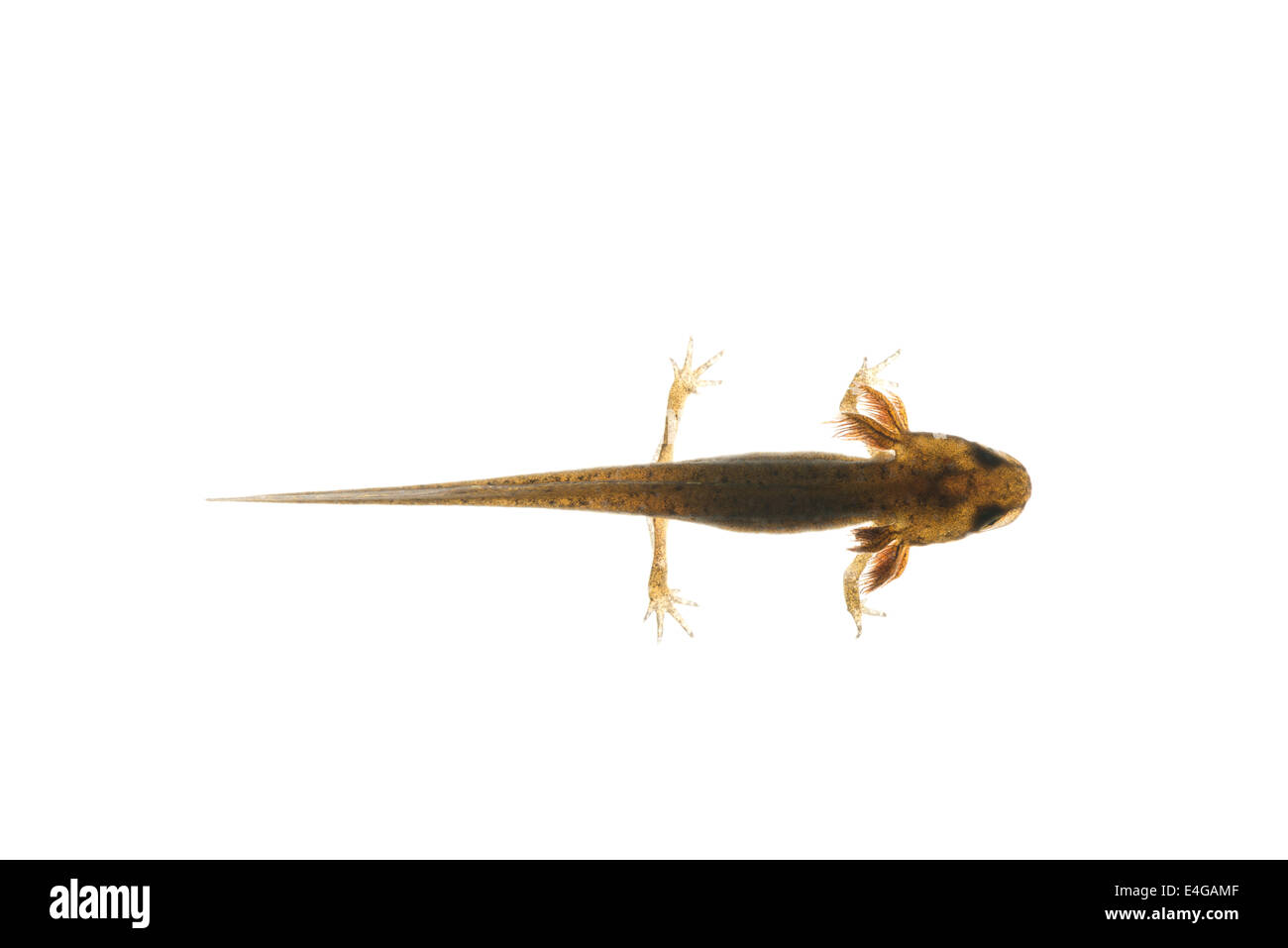 common smooth newt advanced larvae legs developing with external feathery gills will leave pond late summer or autumn 27 mm long Stock Photohttps://www.alamy.com/image-license-details/?v=1https://www.alamy.com/stock-photo-common-smooth-newt-advanced-larvae-legs-developing-with-external-feathery-71659743.html
common smooth newt advanced larvae legs developing with external feathery gills will leave pond late summer or autumn 27 mm long Stock Photohttps://www.alamy.com/image-license-details/?v=1https://www.alamy.com/stock-photo-common-smooth-newt-advanced-larvae-legs-developing-with-external-feathery-71659743.htmlRME4GAMF–common smooth newt advanced larvae legs developing with external feathery gills will leave pond late summer or autumn 27 mm long
 Tadpole of the Common Frog (Rana temporaria) at age 6 to 8 weeks, on a lily-pad. Stock Photohttps://www.alamy.com/image-license-details/?v=1https://www.alamy.com/tadpole-of-the-common-frog-rana-temporaria-at-age-6-to-8-weeks-on-image223360.html
Tadpole of the Common Frog (Rana temporaria) at age 6 to 8 weeks, on a lily-pad. Stock Photohttps://www.alamy.com/image-license-details/?v=1https://www.alamy.com/tadpole-of-the-common-frog-rana-temporaria-at-age-6-to-8-weeks-on-image223360.htmlRMA36880–Tadpole of the Common Frog (Rana temporaria) at age 6 to 8 weeks, on a lily-pad.
 European treefrog, common treefrog, Central European treefrog (Hyla arborea), tadepol with four legs, Germany, Bavaria Stock Photohttps://www.alamy.com/image-license-details/?v=1https://www.alamy.com/european-treefrog-common-treefrog-central-european-treefrog-hyla-arborea-image7631757.html
European treefrog, common treefrog, Central European treefrog (Hyla arborea), tadepol with four legs, Germany, Bavaria Stock Photohttps://www.alamy.com/image-license-details/?v=1https://www.alamy.com/european-treefrog-common-treefrog-central-european-treefrog-hyla-arborea-image7631757.htmlRMADA7ME–European treefrog, common treefrog, Central European treefrog (Hyla arborea), tadepol with four legs, Germany, Bavaria
 EDIBLE FROG tadpole Rana esculenta late internal gill stage with four legs developed Stock Photohttps://www.alamy.com/image-license-details/?v=1https://www.alamy.com/edible-frog-tadpole-rana-esculenta-late-internal-gill-stage-with-four-legs-developed-image181683902.html
EDIBLE FROG tadpole Rana esculenta late internal gill stage with four legs developed Stock Photohttps://www.alamy.com/image-license-details/?v=1https://www.alamy.com/edible-frog-tadpole-rana-esculenta-late-internal-gill-stage-with-four-legs-developed-image181683902.htmlRMMFGBJP–EDIBLE FROG tadpole Rana esculenta late internal gill stage with four legs developed
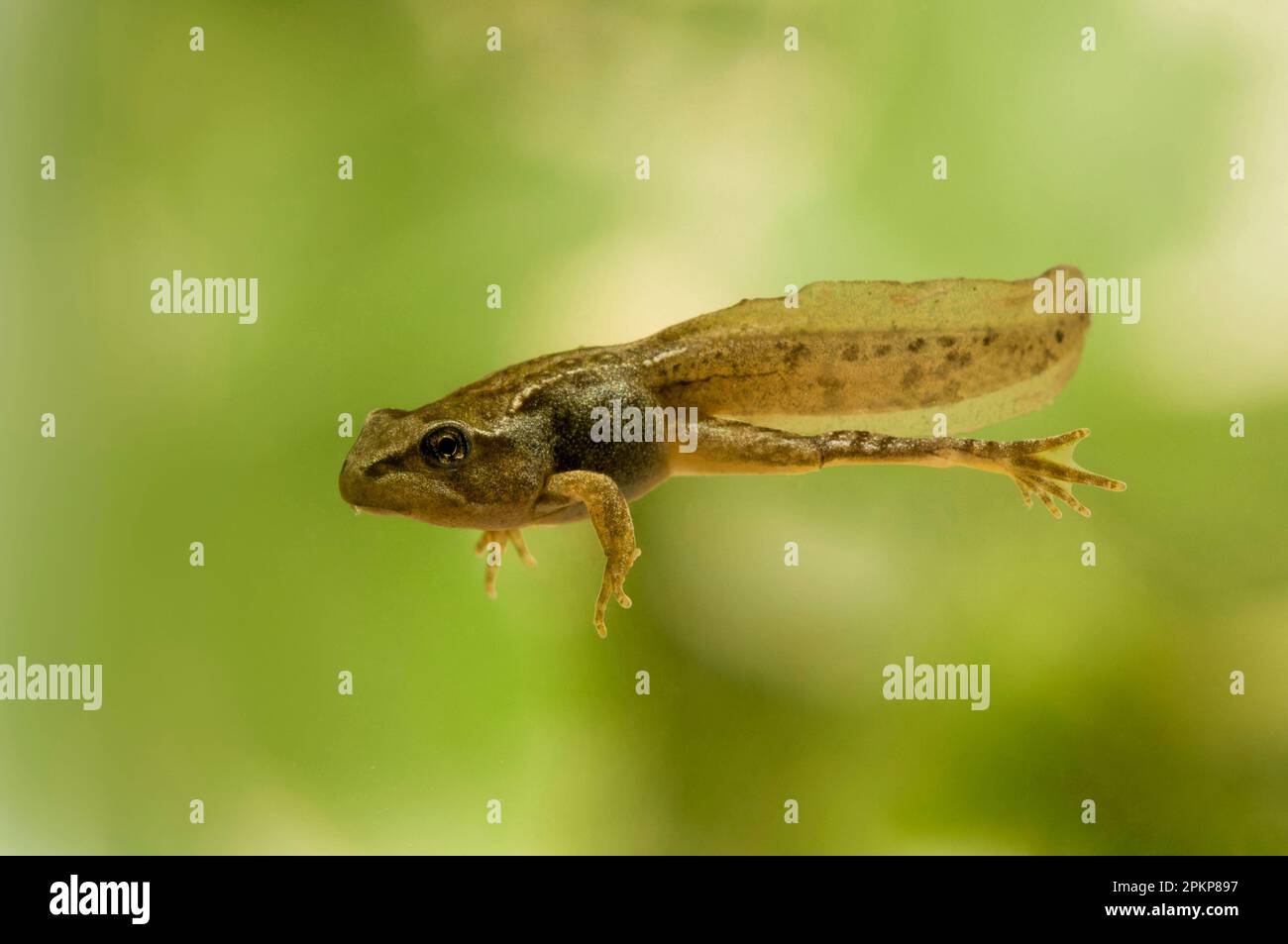 Common common frog (Rana temporaria), partial metamorphosis with all four legs present but still with tail, swimming under water, Belvedere, Bexley, K Stock Photohttps://www.alamy.com/image-license-details/?v=1https://www.alamy.com/common-common-frog-rana-temporaria-partial-metamorphosis-with-all-four-legs-present-but-still-with-tail-swimming-under-water-belvedere-bexley-k-image545689347.html
Common common frog (Rana temporaria), partial metamorphosis with all four legs present but still with tail, swimming under water, Belvedere, Bexley, K Stock Photohttps://www.alamy.com/image-license-details/?v=1https://www.alamy.com/common-common-frog-rana-temporaria-partial-metamorphosis-with-all-four-legs-present-but-still-with-tail-swimming-under-water-belvedere-bexley-k-image545689347.htmlRM2PKP897–Common common frog (Rana temporaria), partial metamorphosis with all four legs present but still with tail, swimming under water, Belvedere, Bexley, K
 . Degeneration : a chapter in Darwinism. Degeneration; Evolution. D EG EN ERA TION. 23 The frog's ^g'g first gives rise to a little aquatic creature with external gills and a tail—the tadpole —which gradually loses its gills and its tail and acquires in their place lungs and four legs (Fig. 2), so as now to be fitted for life on dry land. From what we otherwise know of the structure of the frog;. Fig. 3.—Adult shrimp of the genus Peneus. and the animals to which it is allied, we are justified in concluding that the tadpole is a recapi- tulative phase of development, and represents to us more o Stock Photohttps://www.alamy.com/image-license-details/?v=1https://www.alamy.com/degeneration-a-chapter-in-darwinism-degeneration-evolution-d-eg-en-era-tion-23-the-frogs-gg-first-gives-rise-to-a-little-aquatic-creature-with-external-gills-and-a-tailthe-tadpole-which-gradually-loses-its-gills-and-its-tail-and-acquires-in-their-place-lungs-and-four-legs-fig-2-so-as-now-to-be-fitted-for-life-on-dry-land-from-what-we-otherwise-know-of-the-structure-of-the-frog-fig-3adult-shrimp-of-the-genus-peneus-and-the-animals-to-which-it-is-allied-we-are-justified-in-concluding-that-the-tadpole-is-a-recapi-tulative-phase-of-development-and-represents-to-us-more-o-image231775238.html
. Degeneration : a chapter in Darwinism. Degeneration; Evolution. D EG EN ERA TION. 23 The frog's ^g'g first gives rise to a little aquatic creature with external gills and a tail—the tadpole —which gradually loses its gills and its tail and acquires in their place lungs and four legs (Fig. 2), so as now to be fitted for life on dry land. From what we otherwise know of the structure of the frog;. Fig. 3.—Adult shrimp of the genus Peneus. and the animals to which it is allied, we are justified in concluding that the tadpole is a recapi- tulative phase of development, and represents to us more o Stock Photohttps://www.alamy.com/image-license-details/?v=1https://www.alamy.com/degeneration-a-chapter-in-darwinism-degeneration-evolution-d-eg-en-era-tion-23-the-frogs-gg-first-gives-rise-to-a-little-aquatic-creature-with-external-gills-and-a-tailthe-tadpole-which-gradually-loses-its-gills-and-its-tail-and-acquires-in-their-place-lungs-and-four-legs-fig-2-so-as-now-to-be-fitted-for-life-on-dry-land-from-what-we-otherwise-know-of-the-structure-of-the-frog-fig-3adult-shrimp-of-the-genus-peneus-and-the-animals-to-which-it-is-allied-we-are-justified-in-concluding-that-the-tadpole-is-a-recapi-tulative-phase-of-development-and-represents-to-us-more-o-image231775238.htmlRMRD27K2–. Degeneration : a chapter in Darwinism. Degeneration; Evolution. D EG EN ERA TION. 23 The frog's ^g'g first gives rise to a little aquatic creature with external gills and a tail—the tadpole —which gradually loses its gills and its tail and acquires in their place lungs and four legs (Fig. 2), so as now to be fitted for life on dry land. From what we otherwise know of the structure of the frog;. Fig. 3.—Adult shrimp of the genus Peneus. and the animals to which it is allied, we are justified in concluding that the tadpole is a recapi- tulative phase of development, and represents to us more o
 . Degeneration : a chapter in Darwinism. Degeneration; Evolution. D EG EN ERA TION. 23 The frog's ^g'g first gives rise to a little aquatic creature with external gills and a tail—the tadpole —which gradually loses its gills and its tail and acquires in their place lungs and four legs (Fig. 2), so as now to be fitted for life on dry land. From what we otherwise know of the structure of the frog;. Fig. 3.—Adult shrimp of the genus Peneus. and the animals to which it is allied, we are justified in concluding that the tadpole is a recapi- tulative phase of development, and represents to us more o Stock Photohttps://www.alamy.com/image-license-details/?v=1https://www.alamy.com/degeneration-a-chapter-in-darwinism-degeneration-evolution-d-eg-en-era-tion-23-the-frogs-gg-first-gives-rise-to-a-little-aquatic-creature-with-external-gills-and-a-tailthe-tadpole-which-gradually-loses-its-gills-and-its-tail-and-acquires-in-their-place-lungs-and-four-legs-fig-2-so-as-now-to-be-fitted-for-life-on-dry-land-from-what-we-otherwise-know-of-the-structure-of-the-frog-fig-3adult-shrimp-of-the-genus-peneus-and-the-animals-to-which-it-is-allied-we-are-justified-in-concluding-that-the-tadpole-is-a-recapi-tulative-phase-of-development-and-represents-to-us-more-o-image216226487.html
. Degeneration : a chapter in Darwinism. Degeneration; Evolution. D EG EN ERA TION. 23 The frog's ^g'g first gives rise to a little aquatic creature with external gills and a tail—the tadpole —which gradually loses its gills and its tail and acquires in their place lungs and four legs (Fig. 2), so as now to be fitted for life on dry land. From what we otherwise know of the structure of the frog;. Fig. 3.—Adult shrimp of the genus Peneus. and the animals to which it is allied, we are justified in concluding that the tadpole is a recapi- tulative phase of development, and represents to us more o Stock Photohttps://www.alamy.com/image-license-details/?v=1https://www.alamy.com/degeneration-a-chapter-in-darwinism-degeneration-evolution-d-eg-en-era-tion-23-the-frogs-gg-first-gives-rise-to-a-little-aquatic-creature-with-external-gills-and-a-tailthe-tadpole-which-gradually-loses-its-gills-and-its-tail-and-acquires-in-their-place-lungs-and-four-legs-fig-2-so-as-now-to-be-fitted-for-life-on-dry-land-from-what-we-otherwise-know-of-the-structure-of-the-frog-fig-3adult-shrimp-of-the-genus-peneus-and-the-animals-to-which-it-is-allied-we-are-justified-in-concluding-that-the-tadpole-is-a-recapi-tulative-phase-of-development-and-represents-to-us-more-o-image216226487.htmlRMPFNY2F–. Degeneration : a chapter in Darwinism. Degeneration; Evolution. D EG EN ERA TION. 23 The frog's ^g'g first gives rise to a little aquatic creature with external gills and a tail—the tadpole —which gradually loses its gills and its tail and acquires in their place lungs and four legs (Fig. 2), so as now to be fitted for life on dry land. From what we otherwise know of the structure of the frog;. Fig. 3.—Adult shrimp of the genus Peneus. and the animals to which it is allied, we are justified in concluding that the tadpole is a recapi- tulative phase of development, and represents to us more o
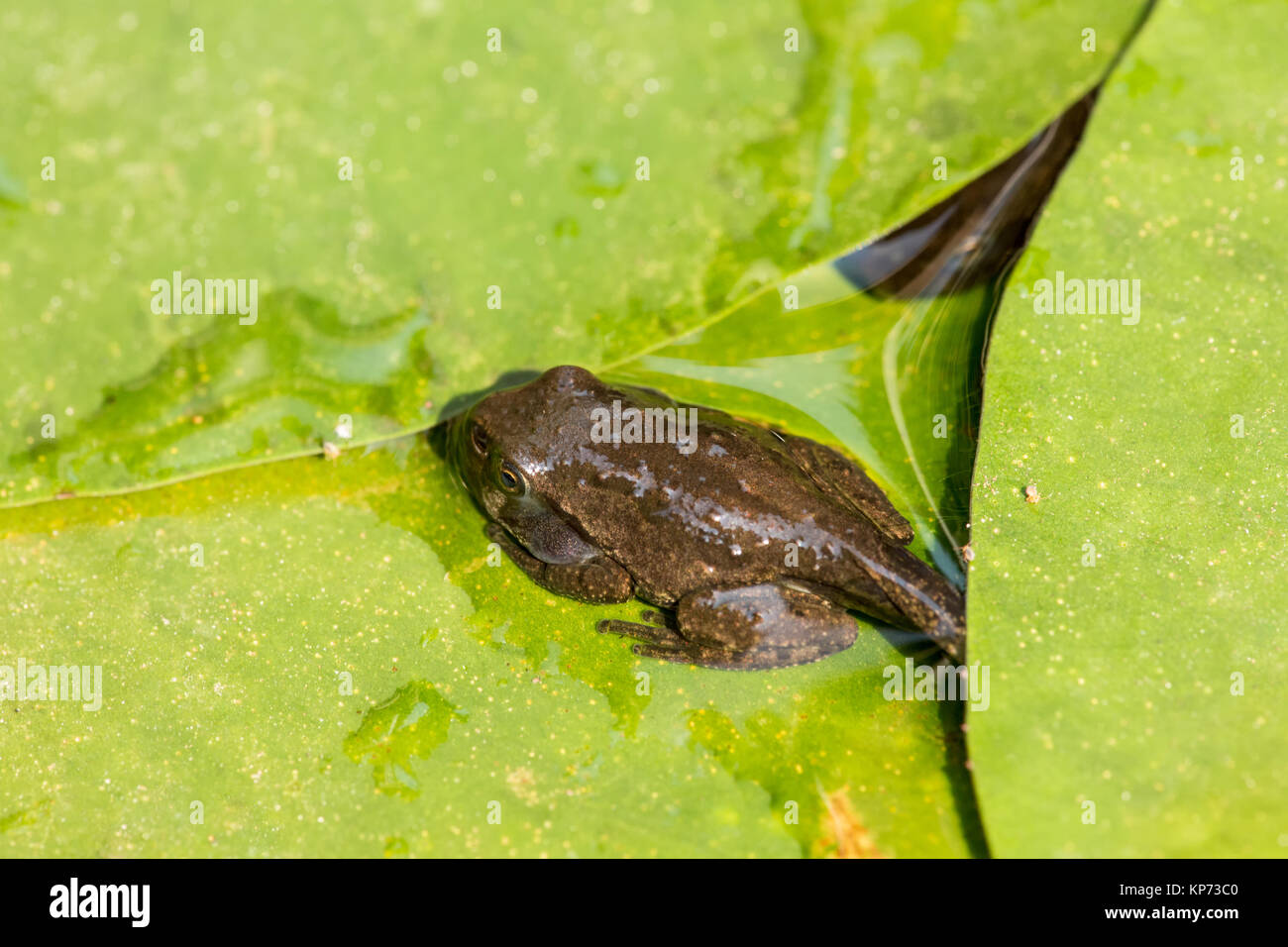 Pacific Tree Frog or Pacific Chorus Frog (Pseudacris regilla) in the tadpole with four legs stage, resting on a water lily pad in a pond in Issaquah, Stock Photohttps://www.alamy.com/image-license-details/?v=1https://www.alamy.com/stock-image-pacific-tree-frog-or-pacific-chorus-frog-pseudacris-regilla-in-the-168572096.html
Pacific Tree Frog or Pacific Chorus Frog (Pseudacris regilla) in the tadpole with four legs stage, resting on a water lily pad in a pond in Issaquah, Stock Photohttps://www.alamy.com/image-license-details/?v=1https://www.alamy.com/stock-image-pacific-tree-frog-or-pacific-chorus-frog-pseudacris-regilla-in-the-168572096.htmlRFKP73C0–Pacific Tree Frog or Pacific Chorus Frog (Pseudacris regilla) in the tadpole with four legs stage, resting on a water lily pad in a pond in Issaquah,
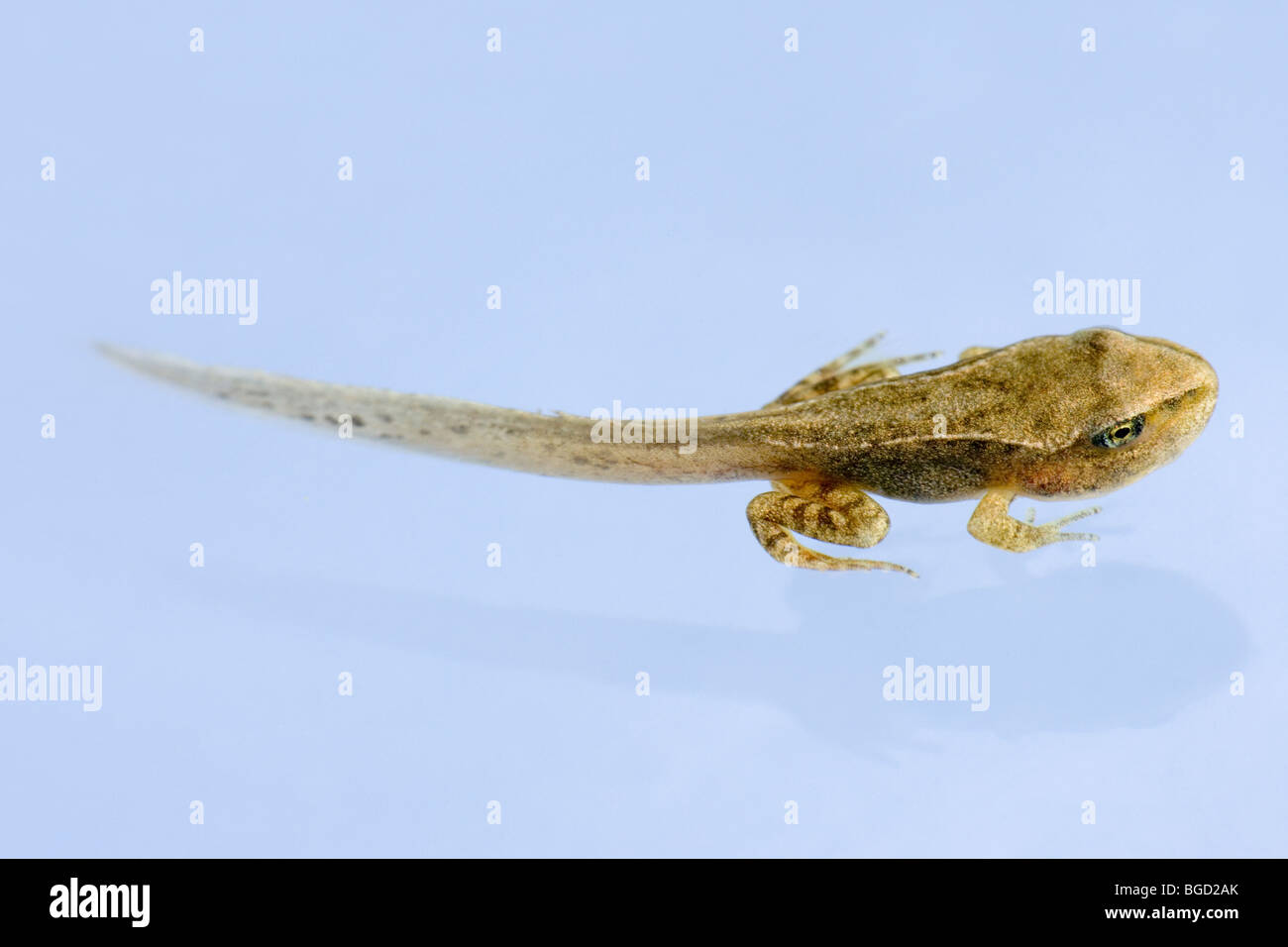 Common Frog (Rana temporaria). Metamorphosis; developmental stage from tadpole to frog. Full length tail. Four legs. Stock Photohttps://www.alamy.com/image-license-details/?v=1https://www.alamy.com/stock-photo-common-frog-rana-temporaria-metamorphosis-developmental-stage-from-27332107.html
Common Frog (Rana temporaria). Metamorphosis; developmental stage from tadpole to frog. Full length tail. Four legs. Stock Photohttps://www.alamy.com/image-license-details/?v=1https://www.alamy.com/stock-photo-common-frog-rana-temporaria-metamorphosis-developmental-stage-from-27332107.htmlRMBGD2AK–Common Frog (Rana temporaria). Metamorphosis; developmental stage from tadpole to frog. Full length tail. Four legs.
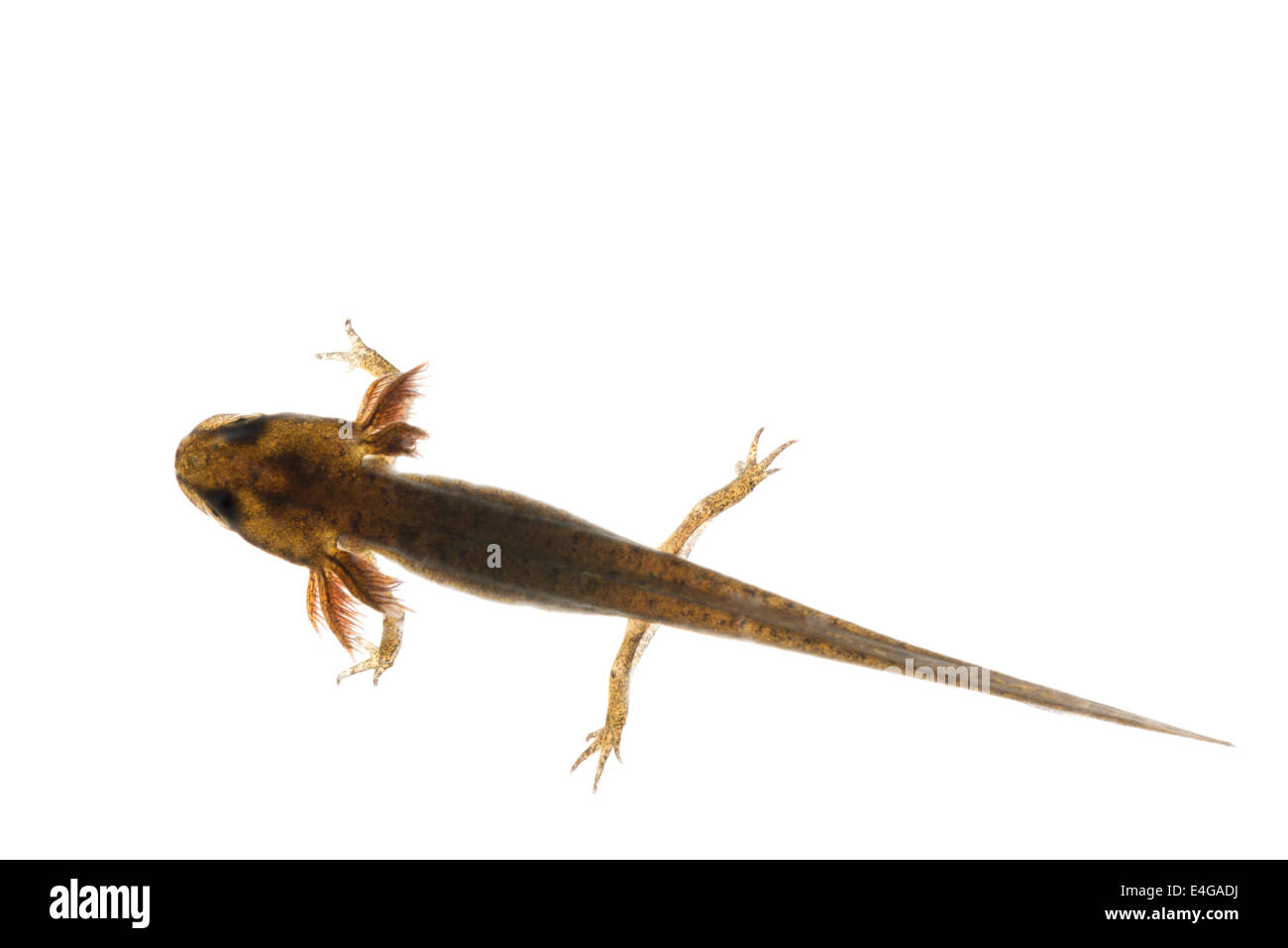 common smooth newt advanced larvae legs developing with external feathery gills will leave pond late summer or autumn 27 mm long Stock Photohttps://www.alamy.com/image-license-details/?v=1https://www.alamy.com/stock-photo-common-smooth-newt-advanced-larvae-legs-developing-with-external-feathery-71659550.html
common smooth newt advanced larvae legs developing with external feathery gills will leave pond late summer or autumn 27 mm long Stock Photohttps://www.alamy.com/image-license-details/?v=1https://www.alamy.com/stock-photo-common-smooth-newt-advanced-larvae-legs-developing-with-external-feathery-71659550.htmlRME4GADJ–common smooth newt advanced larvae legs developing with external feathery gills will leave pond late summer or autumn 27 mm long
 Tadpole of the Common Frog (Rana temporaria) at age 2 to 3 weeks, on a lily-pad. Stock Photohttps://www.alamy.com/image-license-details/?v=1https://www.alamy.com/tadpole-of-the-common-frog-rana-temporaria-at-age-2-to-3-weeks-on-image223359.html
Tadpole of the Common Frog (Rana temporaria) at age 2 to 3 weeks, on a lily-pad. Stock Photohttps://www.alamy.com/image-license-details/?v=1https://www.alamy.com/tadpole-of-the-common-frog-rana-temporaria-at-age-2-to-3-weeks-on-image223359.htmlRMA3687F–Tadpole of the Common Frog (Rana temporaria) at age 2 to 3 weeks, on a lily-pad.
 European edible frog (Rana esculenta), pollywog with four legs, Germany, Bavaria Stock Photohttps://www.alamy.com/image-license-details/?v=1https://www.alamy.com/european-edible-frog-rana-esculenta-pollywog-with-four-legs-germany-image6795478.html
European edible frog (Rana esculenta), pollywog with four legs, Germany, Bavaria Stock Photohttps://www.alamy.com/image-license-details/?v=1https://www.alamy.com/european-edible-frog-rana-esculenta-pollywog-with-four-legs-germany-image6795478.htmlRMA7PKW7–European edible frog (Rana esculenta), pollywog with four legs, Germany, Bavaria
 EDIBLE FROG froglet Rana esculenta four legs, tail reducing Stock Photohttps://www.alamy.com/image-license-details/?v=1https://www.alamy.com/edible-frog-froglet-rana-esculenta-four-legs-tail-reducing-image181699987.html
EDIBLE FROG froglet Rana esculenta four legs, tail reducing Stock Photohttps://www.alamy.com/image-license-details/?v=1https://www.alamy.com/edible-frog-froglet-rana-esculenta-four-legs-tail-reducing-image181699987.htmlRMMFH457–EDIBLE FROG froglet Rana esculenta four legs, tail reducing
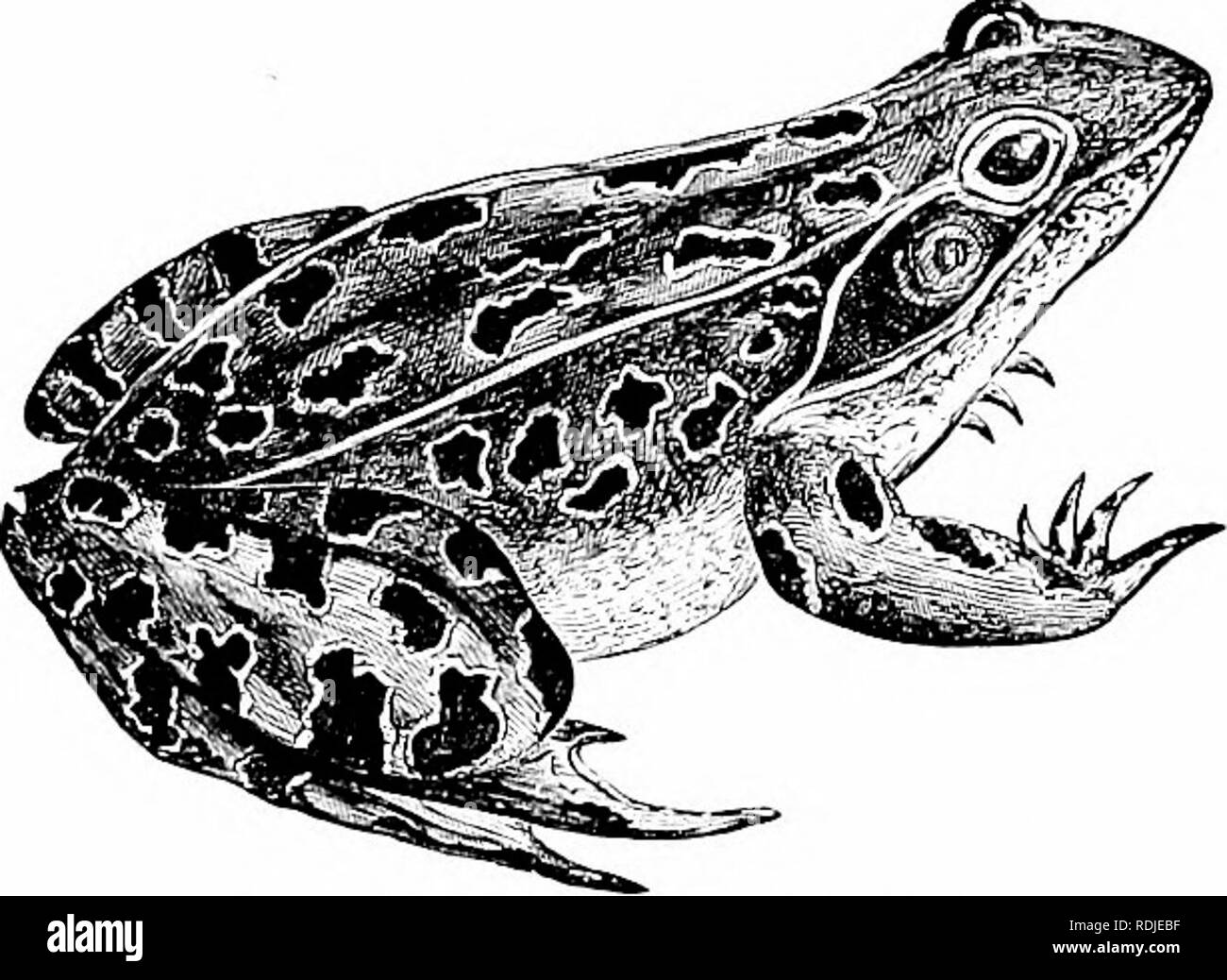 . Natural history of animals;. Zoology. FROGS AND TOADS. 121 breathe by lungs. P'or example, the young frog or tadpole, when first hatched, appears as m Figure 177, with the gills in tufts on the two sides of the neck; later, it appears as in Figure 178, where the gills are concealed; later, it appears as in Figure 179, where it has hind legs; later, as in Figure 180, with four legs; later still, as in Figure 181, where the tail has mostly disappeared ; and later still, it becomes a perfect frog. Frogs and Toads. These have the body short and thick ; the tongue is long and fixed to the fore pa Stock Photohttps://www.alamy.com/image-license-details/?v=1https://www.alamy.com/natural-history-of-animals-zoology-frogs-and-toads-121-breathe-by-lungs-por-example-the-young-frog-or-tadpole-when-first-hatched-appears-as-m-figure-177-with-the-gills-in-tufts-on-the-two-sides-of-the-neck-later-it-appears-as-in-figure-178-where-the-gills-are-concealed-later-it-appears-as-in-figure-179-where-it-has-hind-legs-later-as-in-figure-180-with-four-legs-later-still-as-in-figure-181-where-the-tail-has-mostly-disappeared-and-later-still-it-becomes-a-perfect-frog-frogs-and-toads-these-have-the-body-short-and-thick-the-tongue-is-long-and-fixed-to-the-fore-pa-image232131747.html
. Natural history of animals;. Zoology. FROGS AND TOADS. 121 breathe by lungs. P'or example, the young frog or tadpole, when first hatched, appears as m Figure 177, with the gills in tufts on the two sides of the neck; later, it appears as in Figure 178, where the gills are concealed; later, it appears as in Figure 179, where it has hind legs; later, as in Figure 180, with four legs; later still, as in Figure 181, where the tail has mostly disappeared ; and later still, it becomes a perfect frog. Frogs and Toads. These have the body short and thick ; the tongue is long and fixed to the fore pa Stock Photohttps://www.alamy.com/image-license-details/?v=1https://www.alamy.com/natural-history-of-animals-zoology-frogs-and-toads-121-breathe-by-lungs-por-example-the-young-frog-or-tadpole-when-first-hatched-appears-as-m-figure-177-with-the-gills-in-tufts-on-the-two-sides-of-the-neck-later-it-appears-as-in-figure-178-where-the-gills-are-concealed-later-it-appears-as-in-figure-179-where-it-has-hind-legs-later-as-in-figure-180-with-four-legs-later-still-as-in-figure-181-where-the-tail-has-mostly-disappeared-and-later-still-it-becomes-a-perfect-frog-frogs-and-toads-these-have-the-body-short-and-thick-the-tongue-is-long-and-fixed-to-the-fore-pa-image232131747.htmlRMRDJEBF–. Natural history of animals;. Zoology. FROGS AND TOADS. 121 breathe by lungs. P'or example, the young frog or tadpole, when first hatched, appears as m Figure 177, with the gills in tufts on the two sides of the neck; later, it appears as in Figure 178, where the gills are concealed; later, it appears as in Figure 179, where it has hind legs; later, as in Figure 180, with four legs; later still, as in Figure 181, where the tail has mostly disappeared ; and later still, it becomes a perfect frog. Frogs and Toads. These have the body short and thick ; the tongue is long and fixed to the fore pa
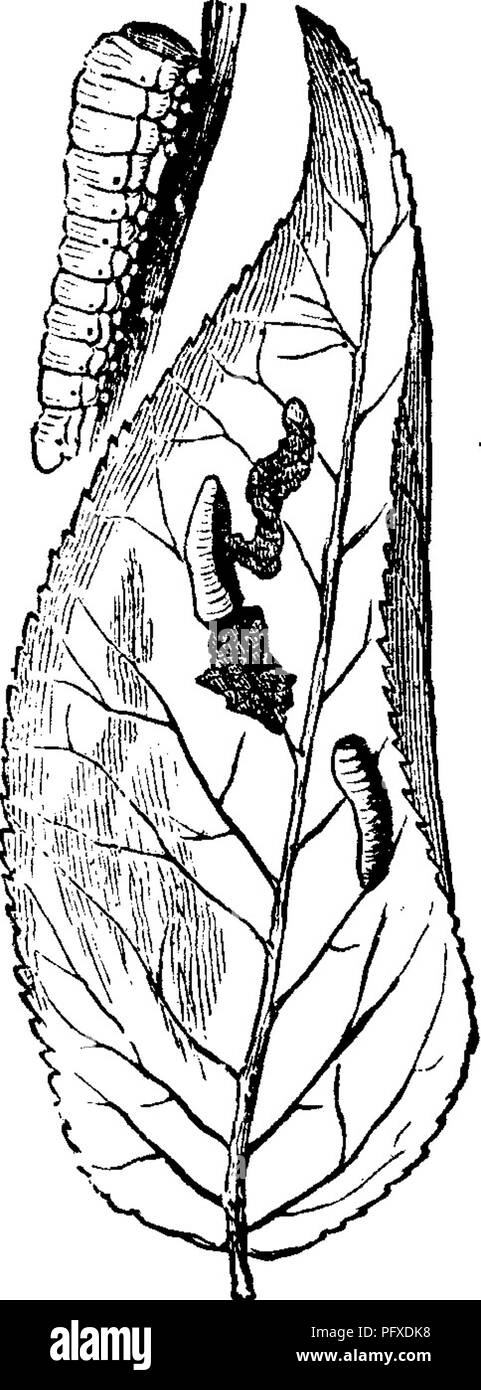 . Insects injurious to fruits. Illustrated with four hundred and forty wood-cuts. Insect pests. 152 INSECTS INJURIOUS TO THE PEAR. Fig. 160.. semble somewhat a tadpole in form, and having a disagreeable and sickening odor. The head is small, of a reddish color, and is almost entirely concealed under the front segments. It is of a dull-yellowish color beneath, with twenty very short legs, one pair under each segment except the fourth and the last. After the last moult it loses its slimy appearance and dark color, and appears in a clean yellow skin en tirely free from slime ; its form is also ch Stock Photohttps://www.alamy.com/image-license-details/?v=1https://www.alamy.com/insects-injurious-to-fruits-illustrated-with-four-hundred-and-forty-wood-cuts-insect-pests-152-insects-injurious-to-the-pear-fig-160-semble-somewhat-a-tadpole-in-form-and-having-a-disagreeable-and-sickening-odor-the-head-is-small-of-a-reddish-color-and-is-almost-entirely-concealed-under-the-front-segments-it-is-of-a-dull-yellowish-color-beneath-with-twenty-very-short-legs-one-pair-under-each-segment-except-the-fourth-and-the-last-after-the-last-moult-it-loses-its-slimy-appearance-and-dark-color-and-appears-in-a-clean-yellow-skin-en-tirely-free-from-slime-its-form-is-also-ch-image216325740.html
. Insects injurious to fruits. Illustrated with four hundred and forty wood-cuts. Insect pests. 152 INSECTS INJURIOUS TO THE PEAR. Fig. 160.. semble somewhat a tadpole in form, and having a disagreeable and sickening odor. The head is small, of a reddish color, and is almost entirely concealed under the front segments. It is of a dull-yellowish color beneath, with twenty very short legs, one pair under each segment except the fourth and the last. After the last moult it loses its slimy appearance and dark color, and appears in a clean yellow skin en tirely free from slime ; its form is also ch Stock Photohttps://www.alamy.com/image-license-details/?v=1https://www.alamy.com/insects-injurious-to-fruits-illustrated-with-four-hundred-and-forty-wood-cuts-insect-pests-152-insects-injurious-to-the-pear-fig-160-semble-somewhat-a-tadpole-in-form-and-having-a-disagreeable-and-sickening-odor-the-head-is-small-of-a-reddish-color-and-is-almost-entirely-concealed-under-the-front-segments-it-is-of-a-dull-yellowish-color-beneath-with-twenty-very-short-legs-one-pair-under-each-segment-except-the-fourth-and-the-last-after-the-last-moult-it-loses-its-slimy-appearance-and-dark-color-and-appears-in-a-clean-yellow-skin-en-tirely-free-from-slime-its-form-is-also-ch-image216325740.htmlRMPFXDK8–. Insects injurious to fruits. Illustrated with four hundred and forty wood-cuts. Insect pests. 152 INSECTS INJURIOUS TO THE PEAR. Fig. 160.. semble somewhat a tadpole in form, and having a disagreeable and sickening odor. The head is small, of a reddish color, and is almost entirely concealed under the front segments. It is of a dull-yellowish color beneath, with twenty very short legs, one pair under each segment except the fourth and the last. After the last moult it loses its slimy appearance and dark color, and appears in a clean yellow skin en tirely free from slime ; its form is also ch
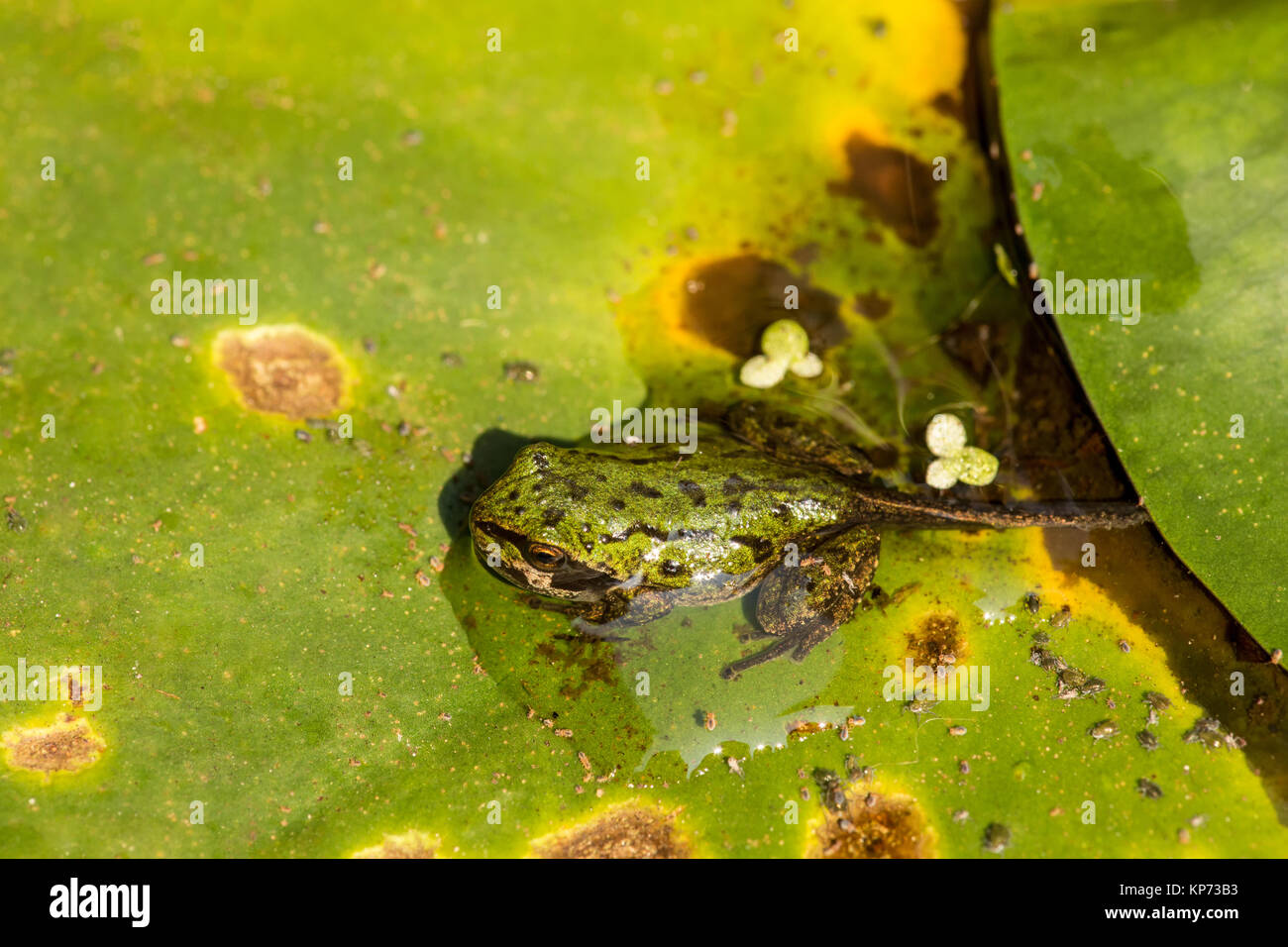 Pacific Tree Frog or Pacific Chorus Frog (Pseudacris regilla) in the tadpole with four legs stage, resting on a water lily pad in a pond in Issaquah, Stock Photohttps://www.alamy.com/image-license-details/?v=1https://www.alamy.com/stock-image-pacific-tree-frog-or-pacific-chorus-frog-pseudacris-regilla-in-the-168572071.html
Pacific Tree Frog or Pacific Chorus Frog (Pseudacris regilla) in the tadpole with four legs stage, resting on a water lily pad in a pond in Issaquah, Stock Photohttps://www.alamy.com/image-license-details/?v=1https://www.alamy.com/stock-image-pacific-tree-frog-or-pacific-chorus-frog-pseudacris-regilla-in-the-168572071.htmlRFKP73B3–Pacific Tree Frog or Pacific Chorus Frog (Pseudacris regilla) in the tadpole with four legs stage, resting on a water lily pad in a pond in Issaquah,
 Common Frog (Rana temporaria). Metamorphosis; developmental stage.Partial tail regression or absorption from tadpole stage. All four legs. Stock Photohttps://www.alamy.com/image-license-details/?v=1https://www.alamy.com/stock-photo-common-frog-rana-temporaria-metamorphosis-developmental-stagepartial-27331991.html
Common Frog (Rana temporaria). Metamorphosis; developmental stage.Partial tail regression or absorption from tadpole stage. All four legs. Stock Photohttps://www.alamy.com/image-license-details/?v=1https://www.alamy.com/stock-photo-common-frog-rana-temporaria-metamorphosis-developmental-stagepartial-27331991.htmlRMBGD26F–Common Frog (Rana temporaria). Metamorphosis; developmental stage.Partial tail regression or absorption from tadpole stage. All four legs.
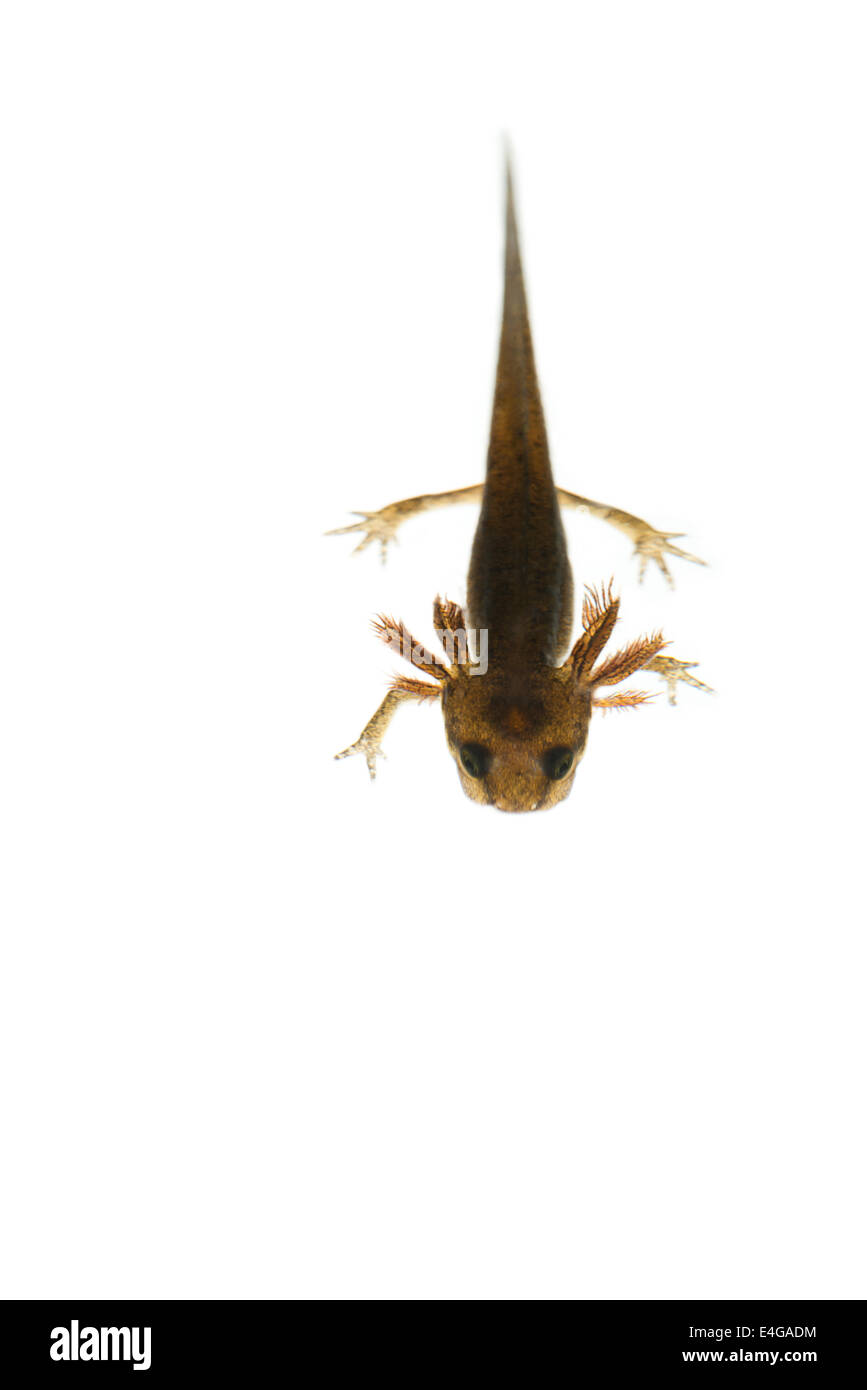 common smooth newt advanced larvae legs developing with external feathery gills will leave pond late summer or autumn 27 mm long Stock Photohttps://www.alamy.com/image-license-details/?v=1https://www.alamy.com/stock-photo-common-smooth-newt-advanced-larvae-legs-developing-with-external-feathery-71659552.html
common smooth newt advanced larvae legs developing with external feathery gills will leave pond late summer or autumn 27 mm long Stock Photohttps://www.alamy.com/image-license-details/?v=1https://www.alamy.com/stock-photo-common-smooth-newt-advanced-larvae-legs-developing-with-external-feathery-71659552.htmlRME4GADM–common smooth newt advanced larvae legs developing with external feathery gills will leave pond late summer or autumn 27 mm long
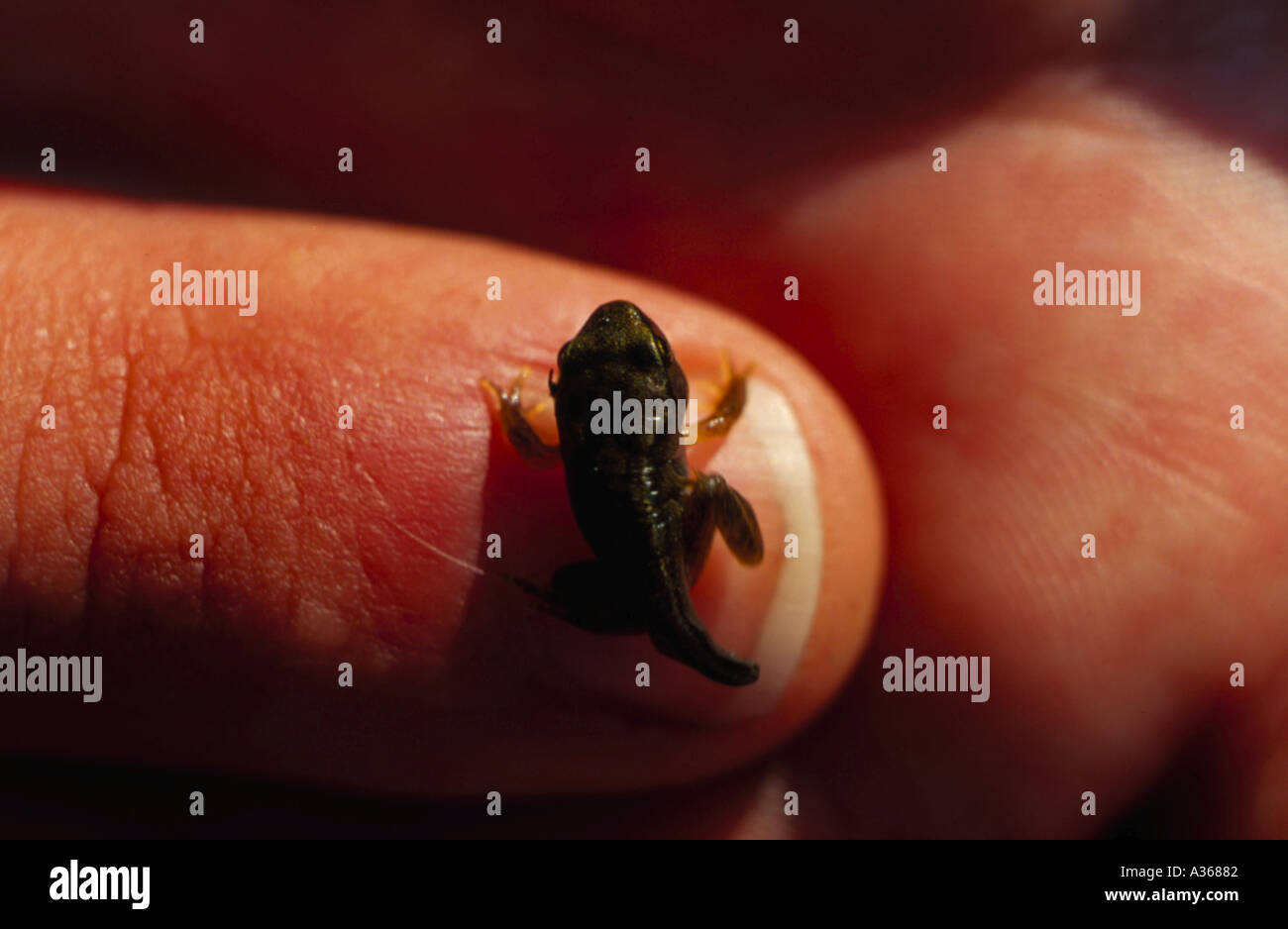 Tadpole of the Common Frog (Rana temporaria) at age 10 to 12 weeks. Stock Photohttps://www.alamy.com/image-license-details/?v=1https://www.alamy.com/tadpole-of-the-common-frog-rana-temporaria-at-age-10-to-12-weeks-image223362.html
Tadpole of the Common Frog (Rana temporaria) at age 10 to 12 weeks. Stock Photohttps://www.alamy.com/image-license-details/?v=1https://www.alamy.com/tadpole-of-the-common-frog-rana-temporaria-at-age-10-to-12-weeks-image223362.htmlRMA36882–Tadpole of the Common Frog (Rana temporaria) at age 10 to 12 weeks.
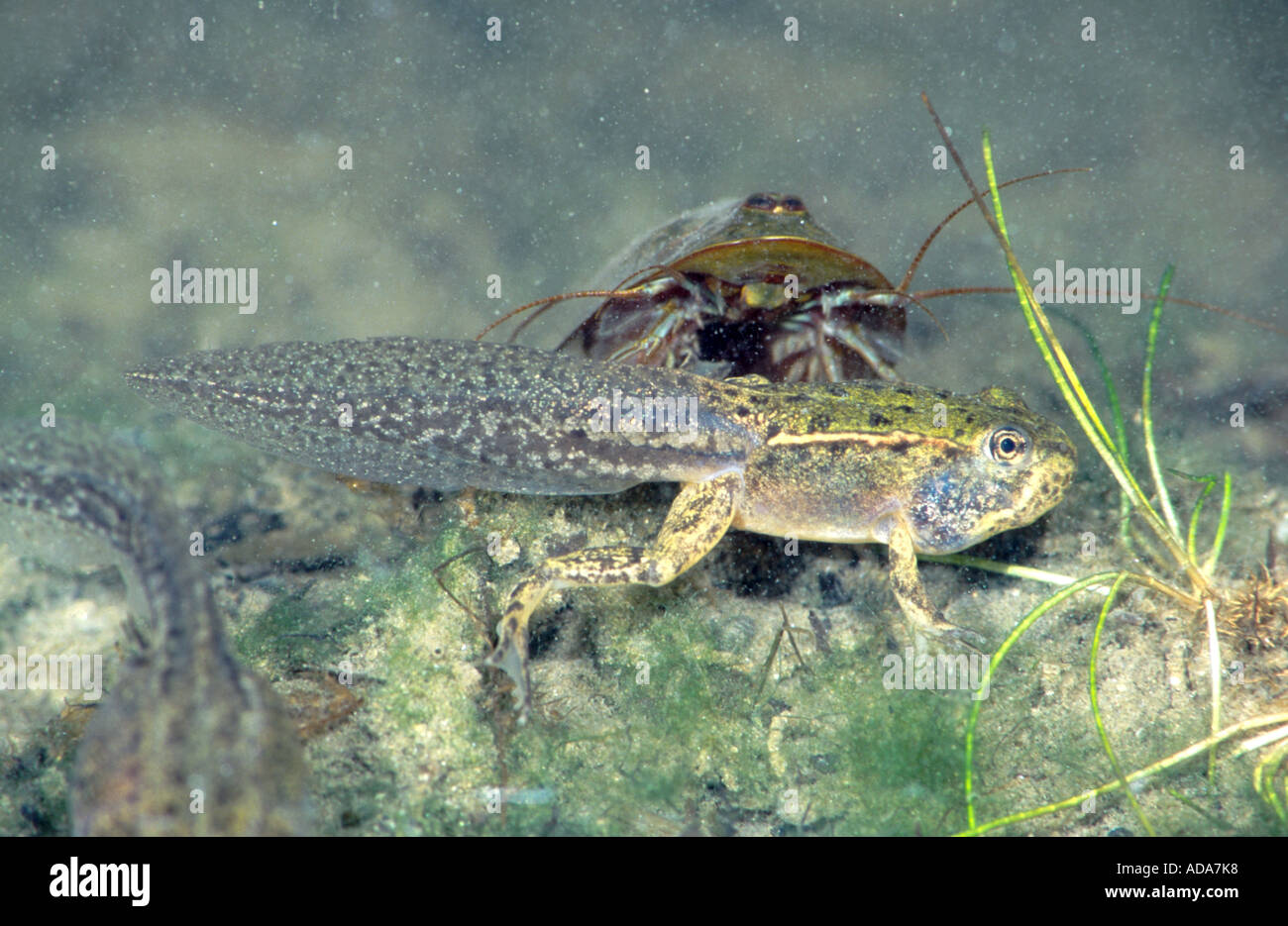 European edible frog and tadpole shrimp, freshwater tadpole shrimp, rice apus (Rana esculenta, Triops cancriformis), tadpole wi Stock Photohttps://www.alamy.com/image-license-details/?v=1https://www.alamy.com/european-edible-frog-and-tadpole-shrimp-freshwater-tadpole-shrimp-image7631735.html
European edible frog and tadpole shrimp, freshwater tadpole shrimp, rice apus (Rana esculenta, Triops cancriformis), tadpole wi Stock Photohttps://www.alamy.com/image-license-details/?v=1https://www.alamy.com/european-edible-frog-and-tadpole-shrimp-freshwater-tadpole-shrimp-image7631735.htmlRMADA7K8–European edible frog and tadpole shrimp, freshwater tadpole shrimp, rice apus (Rana esculenta, Triops cancriformis), tadpole wi
 . Insects injurious to fruits. Illustrated with four hundred and forty wood-cuts. Insect pests. 152 INSECTS INJURIOUS TO THE PEAR. Fig. 160.. semble somewhat a tadpole in form, and having a disagreeable and sickening odor. The head is small, of a reddish color, and is almost entirely concealed under the front segments. It is of a dull-yellowish color beneath, with twenty very short legs, one pair under each segment except the fourth and the last. After the last moult it loses its slimy appearance and dark color, and appears in a clean yellow skin en tirely free from slime ; its form is also ch Stock Photohttps://www.alamy.com/image-license-details/?v=1https://www.alamy.com/insects-injurious-to-fruits-illustrated-with-four-hundred-and-forty-wood-cuts-insect-pests-152-insects-injurious-to-the-pear-fig-160-semble-somewhat-a-tadpole-in-form-and-having-a-disagreeable-and-sickening-odor-the-head-is-small-of-a-reddish-color-and-is-almost-entirely-concealed-under-the-front-segments-it-is-of-a-dull-yellowish-color-beneath-with-twenty-very-short-legs-one-pair-under-each-segment-except-the-fourth-and-the-last-after-the-last-moult-it-loses-its-slimy-appearance-and-dark-color-and-appears-in-a-clean-yellow-skin-en-tirely-free-from-slime-its-form-is-also-ch-image231893429.html
. Insects injurious to fruits. Illustrated with four hundred and forty wood-cuts. Insect pests. 152 INSECTS INJURIOUS TO THE PEAR. Fig. 160.. semble somewhat a tadpole in form, and having a disagreeable and sickening odor. The head is small, of a reddish color, and is almost entirely concealed under the front segments. It is of a dull-yellowish color beneath, with twenty very short legs, one pair under each segment except the fourth and the last. After the last moult it loses its slimy appearance and dark color, and appears in a clean yellow skin en tirely free from slime ; its form is also ch Stock Photohttps://www.alamy.com/image-license-details/?v=1https://www.alamy.com/insects-injurious-to-fruits-illustrated-with-four-hundred-and-forty-wood-cuts-insect-pests-152-insects-injurious-to-the-pear-fig-160-semble-somewhat-a-tadpole-in-form-and-having-a-disagreeable-and-sickening-odor-the-head-is-small-of-a-reddish-color-and-is-almost-entirely-concealed-under-the-front-segments-it-is-of-a-dull-yellowish-color-beneath-with-twenty-very-short-legs-one-pair-under-each-segment-except-the-fourth-and-the-last-after-the-last-moult-it-loses-its-slimy-appearance-and-dark-color-and-appears-in-a-clean-yellow-skin-en-tirely-free-from-slime-its-form-is-also-ch-image231893429.htmlRMRD7JC5–. Insects injurious to fruits. Illustrated with four hundred and forty wood-cuts. Insect pests. 152 INSECTS INJURIOUS TO THE PEAR. Fig. 160.. semble somewhat a tadpole in form, and having a disagreeable and sickening odor. The head is small, of a reddish color, and is almost entirely concealed under the front segments. It is of a dull-yellowish color beneath, with twenty very short legs, one pair under each segment except the fourth and the last. After the last moult it loses its slimy appearance and dark color, and appears in a clean yellow skin en tirely free from slime ; its form is also ch
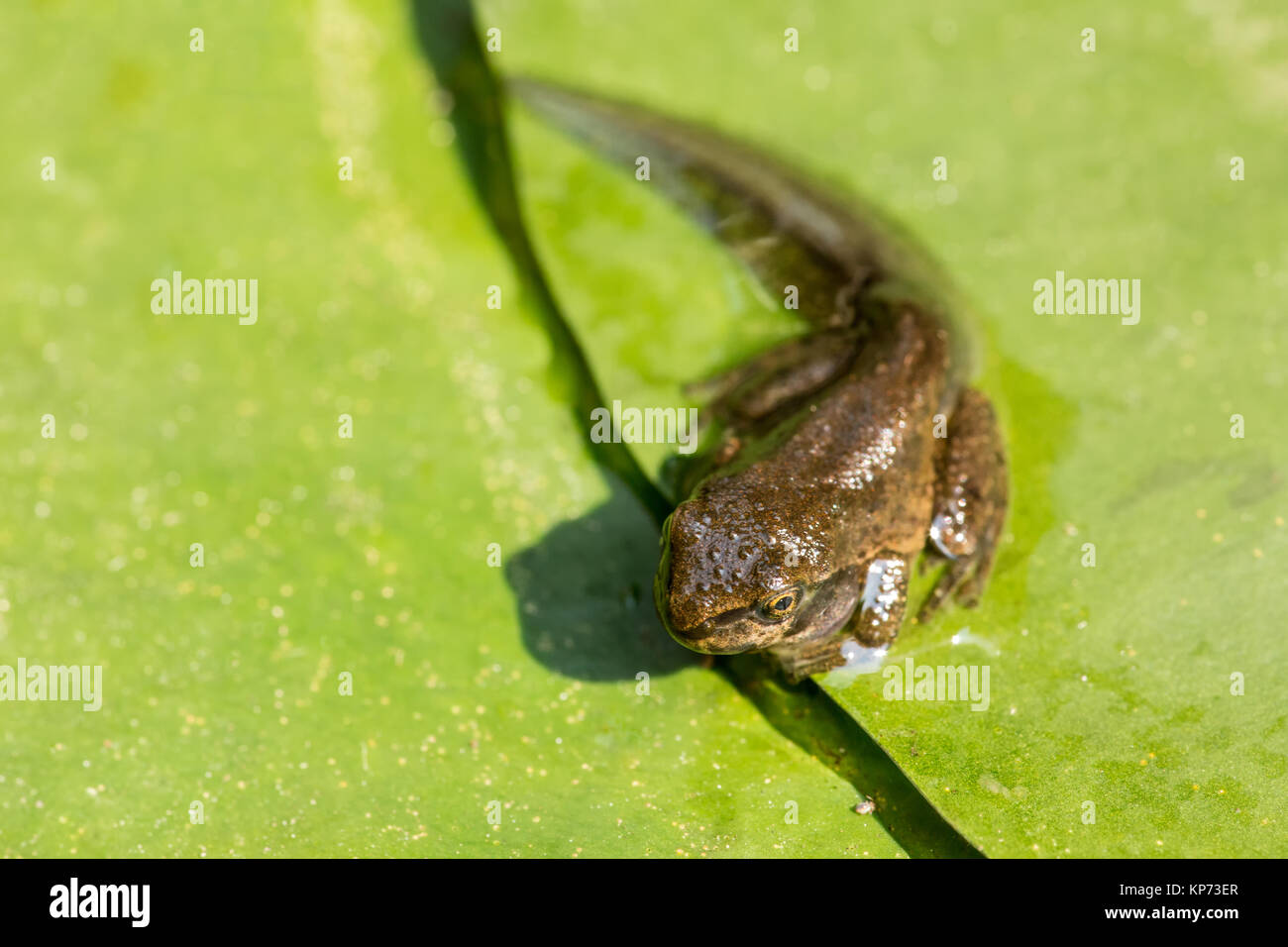 Pacific Tree Frog or Pacific Chorus Frog (Pseudacris regilla) in the tadpole with four legs stage, resting on a water lily pad in a pond in Issaquah, Stock Photohttps://www.alamy.com/image-license-details/?v=1https://www.alamy.com/stock-image-pacific-tree-frog-or-pacific-chorus-frog-pseudacris-regilla-in-the-168572175.html
Pacific Tree Frog or Pacific Chorus Frog (Pseudacris regilla) in the tadpole with four legs stage, resting on a water lily pad in a pond in Issaquah, Stock Photohttps://www.alamy.com/image-license-details/?v=1https://www.alamy.com/stock-image-pacific-tree-frog-or-pacific-chorus-frog-pseudacris-regilla-in-the-168572175.htmlRFKP73ER–Pacific Tree Frog or Pacific Chorus Frog (Pseudacris regilla) in the tadpole with four legs stage, resting on a water lily pad in a pond in Issaquah,
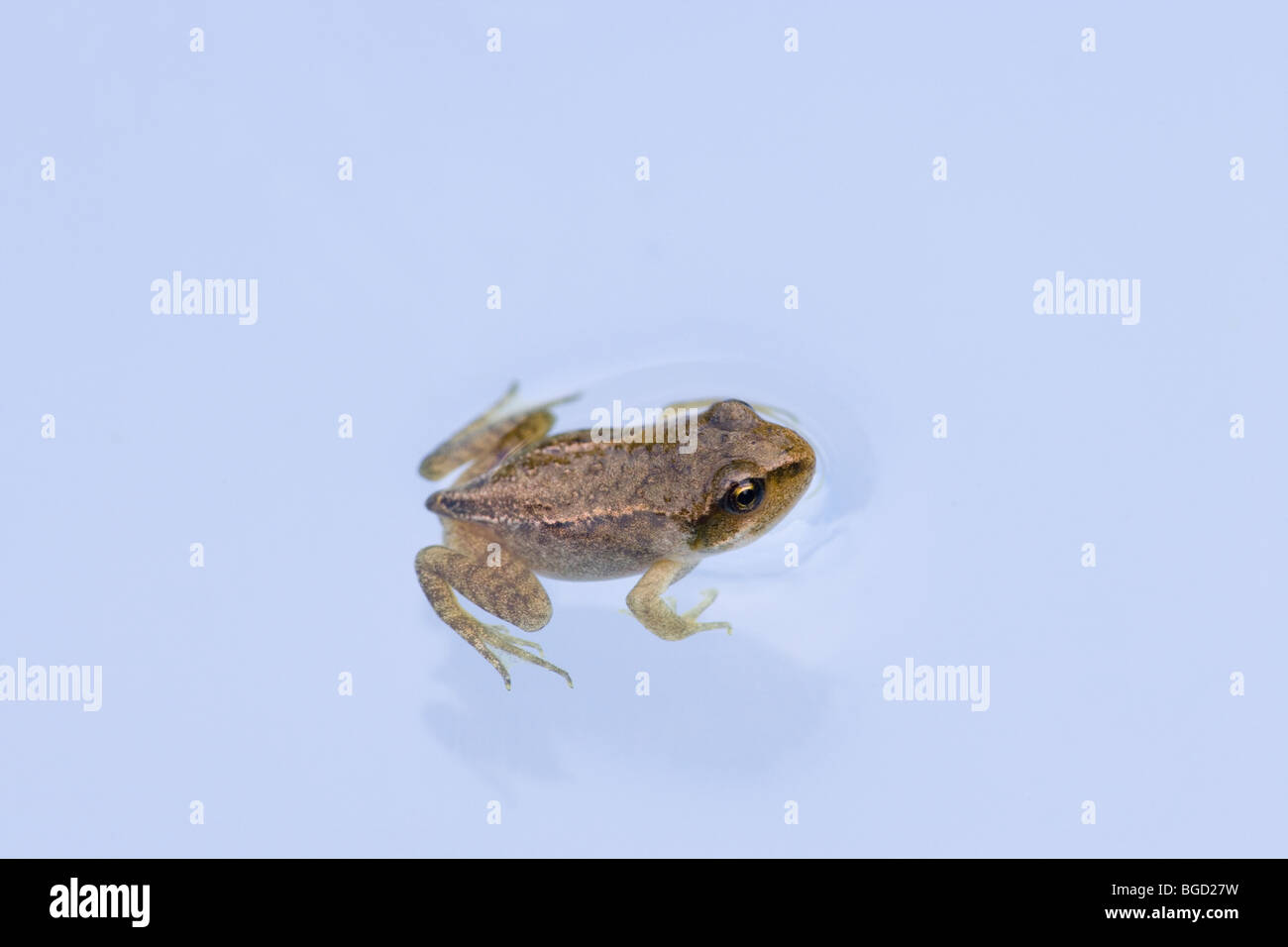 Common Frog (Rana temporaria). Metamorphosis. The developmental stage from tadpole. Tail regression or absorption, NEARLY COMPLETE. All four legs. Stock Photohttps://www.alamy.com/image-license-details/?v=1https://www.alamy.com/stock-photo-common-frog-rana-temporaria-metamorphosis-the-developmental-stage-27332029.html
Common Frog (Rana temporaria). Metamorphosis. The developmental stage from tadpole. Tail regression or absorption, NEARLY COMPLETE. All four legs. Stock Photohttps://www.alamy.com/image-license-details/?v=1https://www.alamy.com/stock-photo-common-frog-rana-temporaria-metamorphosis-the-developmental-stage-27332029.htmlRMBGD27W–Common Frog (Rana temporaria). Metamorphosis. The developmental stage from tadpole. Tail regression or absorption, NEARLY COMPLETE. All four legs.
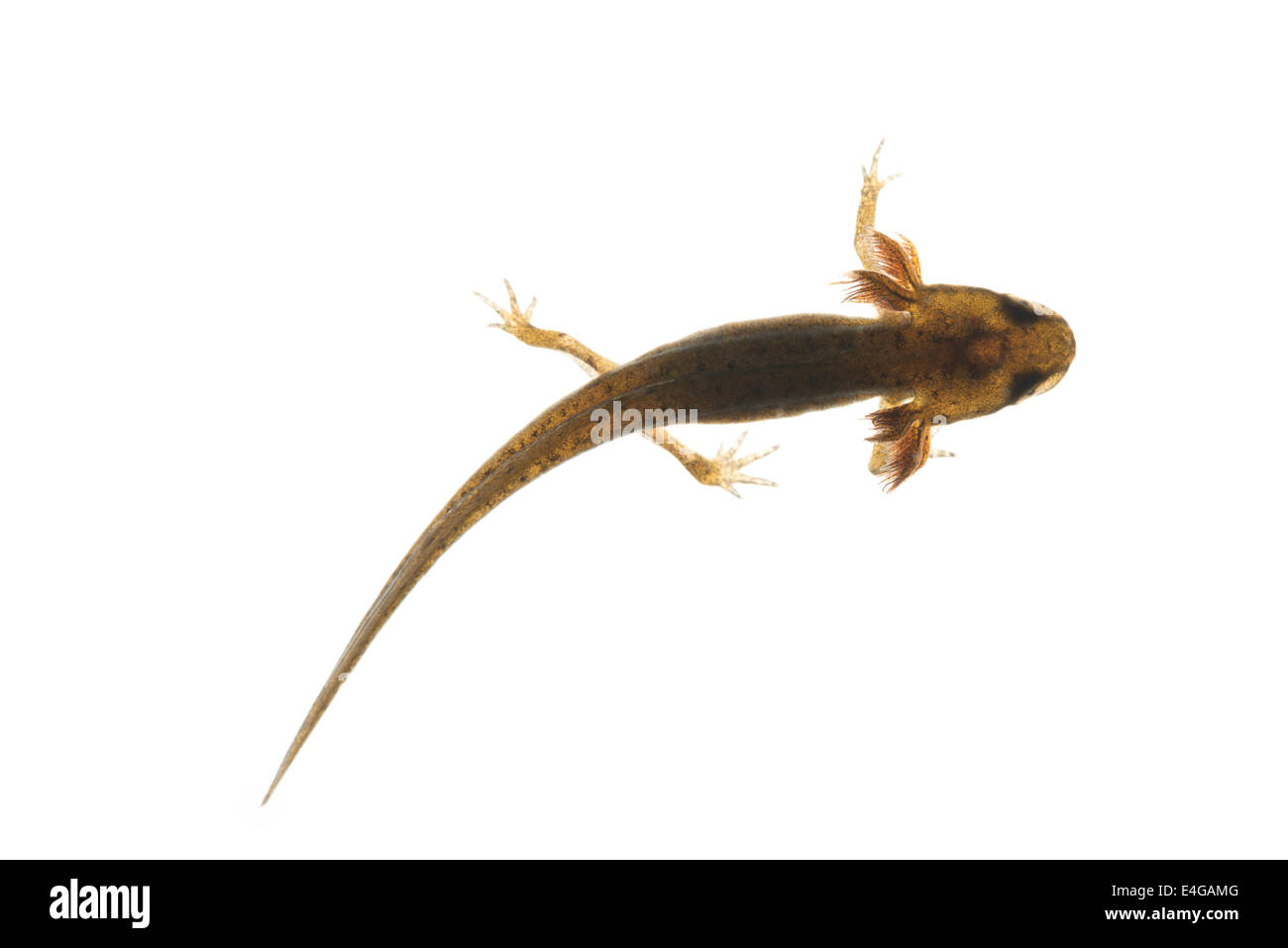 common smooth newt advanced larvae legs developing with external feathery gills will leave pond late summer or autumn 27 mm long Stock Photohttps://www.alamy.com/image-license-details/?v=1https://www.alamy.com/stock-photo-common-smooth-newt-advanced-larvae-legs-developing-with-external-feathery-71659744.html
common smooth newt advanced larvae legs developing with external feathery gills will leave pond late summer or autumn 27 mm long Stock Photohttps://www.alamy.com/image-license-details/?v=1https://www.alamy.com/stock-photo-common-smooth-newt-advanced-larvae-legs-developing-with-external-feathery-71659744.htmlRME4GAMG–common smooth newt advanced larvae legs developing with external feathery gills will leave pond late summer or autumn 27 mm long
 Tadpole of the Common Frog (Rana temporaria) at age 10 weeks, on a lily-pad. Stock Photohttps://www.alamy.com/image-license-details/?v=1https://www.alamy.com/tadpole-of-the-common-frog-rana-temporaria-at-age-10-weeks-on-a-lily-image223361.html
Tadpole of the Common Frog (Rana temporaria) at age 10 weeks, on a lily-pad. Stock Photohttps://www.alamy.com/image-license-details/?v=1https://www.alamy.com/tadpole-of-the-common-frog-rana-temporaria-at-age-10-weeks-on-a-lily-image223361.htmlRMA36881–Tadpole of the Common Frog (Rana temporaria) at age 10 weeks, on a lily-pad.
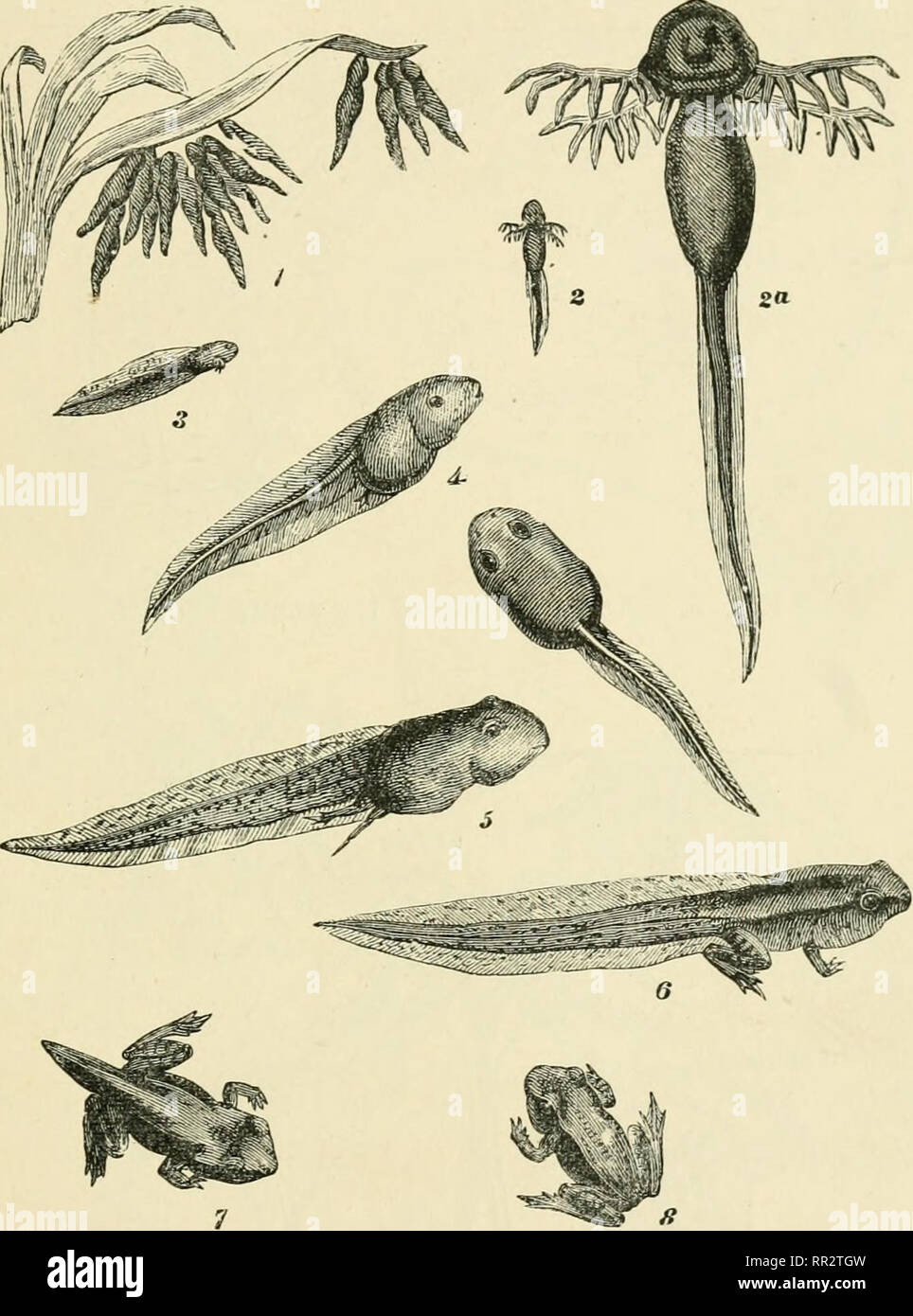 . The advancement of science. Occasional essays & addresses. Natural history. A CHAPTER IN DARWINISM 19 The frog's egg first gives rise to a little aquatic creature with external gills and a tail—the tadpole— which gradually loses its gills and its tail and acquires in their place lungs and four legs (Fig. 2), so as now. Fig, 2.—Tadpoles and young of the Common Frog. 1, Eeceutly hatched (twice natural size) ; 2 and 2a, same enlarged to show the external gills ; 3 and 4, later stages with gill-slits covered by a membrane leaving only the spiracle (see Fig. 16) as an exit for the respired wa Stock Photohttps://www.alamy.com/image-license-details/?v=1https://www.alamy.com/the-advancement-of-science-occasional-essays-amp-addresses-natural-history-a-chapter-in-darwinism-19-the-frogs-egg-first-gives-rise-to-a-little-aquatic-creature-with-external-gills-and-a-tailthe-tadpole-which-gradually-loses-its-gills-and-its-tail-and-acquires-in-their-place-lungs-and-four-legs-fig-2-so-as-now-fig-2tadpoles-and-young-of-the-common-frog-1-eeceutly-hatched-twice-natural-size-2-and-2a-same-enlarged-to-show-the-external-gills-3-and-4-later-stages-with-gill-slits-covered-by-a-membrane-leaving-only-the-spiracle-see-fig-16-as-an-exit-for-the-respired-wa-image237935065.html
. The advancement of science. Occasional essays & addresses. Natural history. A CHAPTER IN DARWINISM 19 The frog's egg first gives rise to a little aquatic creature with external gills and a tail—the tadpole— which gradually loses its gills and its tail and acquires in their place lungs and four legs (Fig. 2), so as now. Fig, 2.—Tadpoles and young of the Common Frog. 1, Eeceutly hatched (twice natural size) ; 2 and 2a, same enlarged to show the external gills ; 3 and 4, later stages with gill-slits covered by a membrane leaving only the spiracle (see Fig. 16) as an exit for the respired wa Stock Photohttps://www.alamy.com/image-license-details/?v=1https://www.alamy.com/the-advancement-of-science-occasional-essays-amp-addresses-natural-history-a-chapter-in-darwinism-19-the-frogs-egg-first-gives-rise-to-a-little-aquatic-creature-with-external-gills-and-a-tailthe-tadpole-which-gradually-loses-its-gills-and-its-tail-and-acquires-in-their-place-lungs-and-four-legs-fig-2-so-as-now-fig-2tadpoles-and-young-of-the-common-frog-1-eeceutly-hatched-twice-natural-size-2-and-2a-same-enlarged-to-show-the-external-gills-3-and-4-later-stages-with-gill-slits-covered-by-a-membrane-leaving-only-the-spiracle-see-fig-16-as-an-exit-for-the-respired-wa-image237935065.htmlRMRR2TGW–. The advancement of science. Occasional essays & addresses. Natural history. A CHAPTER IN DARWINISM 19 The frog's egg first gives rise to a little aquatic creature with external gills and a tail—the tadpole— which gradually loses its gills and its tail and acquires in their place lungs and four legs (Fig. 2), so as now. Fig, 2.—Tadpoles and young of the Common Frog. 1, Eeceutly hatched (twice natural size) ; 2 and 2a, same enlarged to show the external gills ; 3 and 4, later stages with gill-slits covered by a membrane leaving only the spiracle (see Fig. 16) as an exit for the respired wa
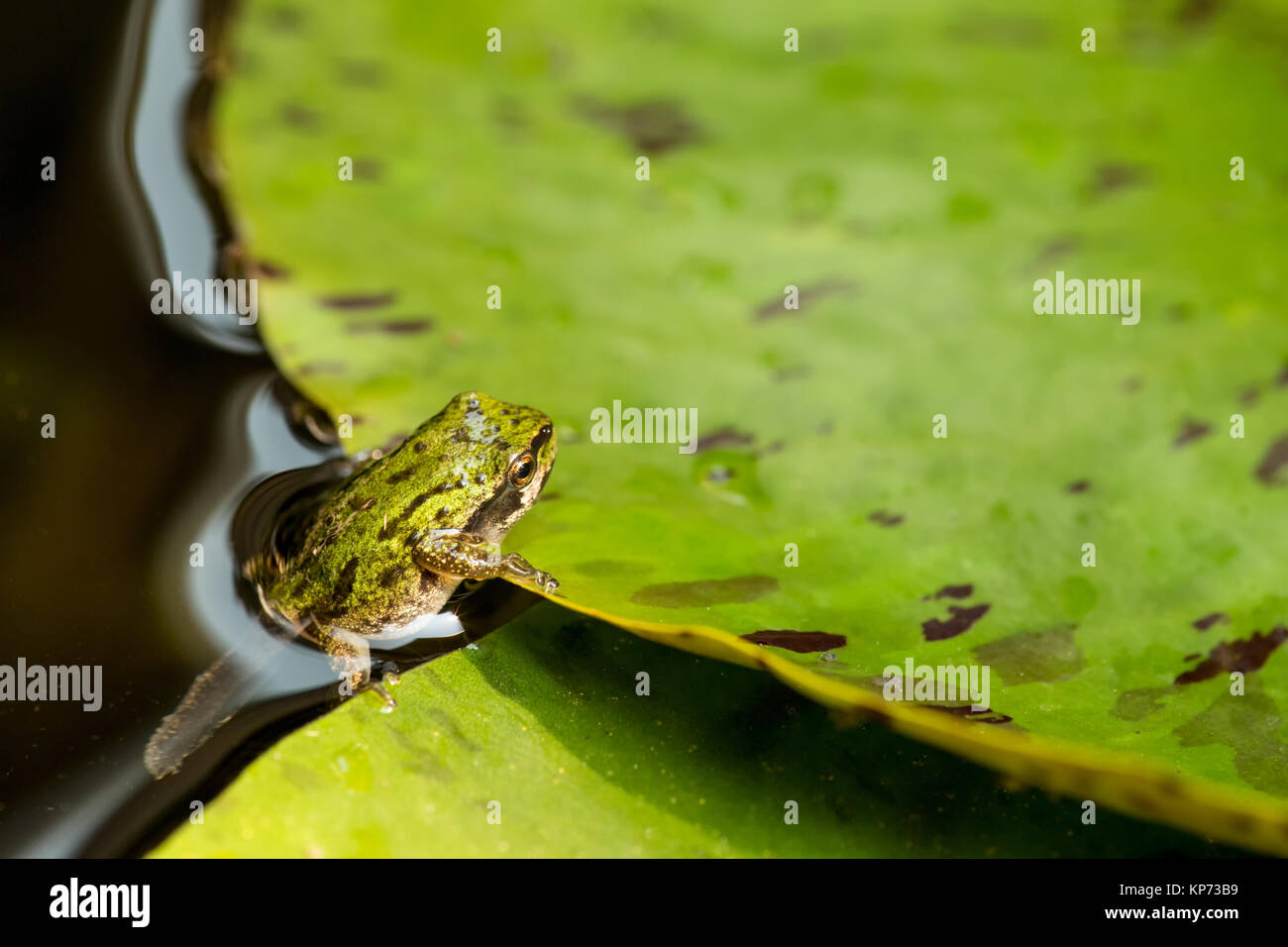 Pacific Tree Frog or Pacific Chorus Frog (Pseudacris regilla) in the tadpole with four legs stage, resting on a water lily pad in a pond in Issaquah, Stock Photohttps://www.alamy.com/image-license-details/?v=1https://www.alamy.com/stock-image-pacific-tree-frog-or-pacific-chorus-frog-pseudacris-regilla-in-the-168572077.html
Pacific Tree Frog or Pacific Chorus Frog (Pseudacris regilla) in the tadpole with four legs stage, resting on a water lily pad in a pond in Issaquah, Stock Photohttps://www.alamy.com/image-license-details/?v=1https://www.alamy.com/stock-image-pacific-tree-frog-or-pacific-chorus-frog-pseudacris-regilla-in-the-168572077.htmlRFKP73B9–Pacific Tree Frog or Pacific Chorus Frog (Pseudacris regilla) in the tadpole with four legs stage, resting on a water lily pad in a pond in Issaquah,
 A Pacific Tree tadpole which has sprouted legs, but no arms, and still has a tail. In a pond in Issaquah, Washington, USA. Stock Photohttps://www.alamy.com/image-license-details/?v=1https://www.alamy.com/a-pacific-tree-tadpole-which-has-sprouted-legs-but-no-arms-and-still-has-a-tail-in-a-pond-in-issaquah-washington-usa-image367817573.html
A Pacific Tree tadpole which has sprouted legs, but no arms, and still has a tail. In a pond in Issaquah, Washington, USA. Stock Photohttps://www.alamy.com/image-license-details/?v=1https://www.alamy.com/a-pacific-tree-tadpole-which-has-sprouted-legs-but-no-arms-and-still-has-a-tail-in-a-pond-in-issaquah-washington-usa-image367817573.htmlRF2CABF1W–A Pacific Tree tadpole which has sprouted legs, but no arms, and still has a tail. In a pond in Issaquah, Washington, USA.
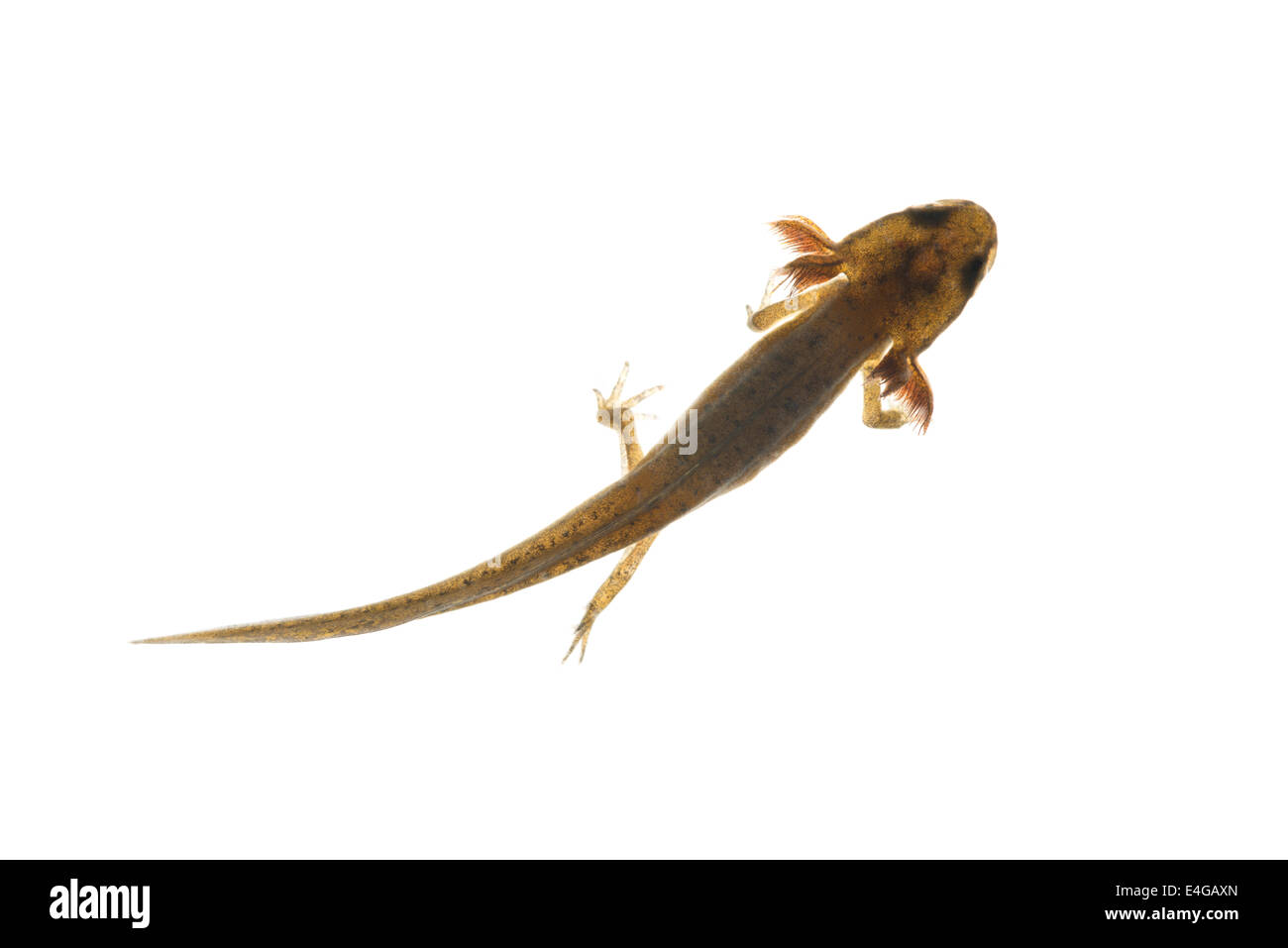 common smooth newt advanced larvae legs developing with external feathery gills will leave pond late summer or autumn 27 mm long Stock Photohttps://www.alamy.com/image-license-details/?v=1https://www.alamy.com/stock-photo-common-smooth-newt-advanced-larvae-legs-developing-with-external-feathery-71659917.html
common smooth newt advanced larvae legs developing with external feathery gills will leave pond late summer or autumn 27 mm long Stock Photohttps://www.alamy.com/image-license-details/?v=1https://www.alamy.com/stock-photo-common-smooth-newt-advanced-larvae-legs-developing-with-external-feathery-71659917.htmlRME4GAXN–common smooth newt advanced larvae legs developing with external feathery gills will leave pond late summer or autumn 27 mm long
 . A civic biology : presented in problems. Biology; Sanitation. Development of a frog. 1, two cell stage ; 2, four cell stage; 3, 8 cells are formed, notice the upper cells are smaller; in (4) the lower cells are seen to be much larger because of the yoke ; 5, the egg has continued to divide and has formed a gastrula ; 6, 7, the body is lengthening, head is seen at the right hand end ; 8, the young tadpole with external gills; 9, 10, the gills are internal, hind legs beginning to form; 11, the hind legs show plainly; 12, 13, 14, later stages in development; 15, the adult frog. Figures 1, 2, 3, Stock Photohttps://www.alamy.com/image-license-details/?v=1https://www.alamy.com/a-civic-biology-presented-in-problems-biology-sanitation-development-of-a-frog-1-two-cell-stage-2-four-cell-stage-3-8-cells-are-formed-notice-the-upper-cells-are-smaller-in-4-the-lower-cells-are-seen-to-be-much-larger-because-of-the-yoke-5-the-egg-has-continued-to-divide-and-has-formed-a-gastrula-6-7-the-body-is-lengthening-head-is-seen-at-the-right-hand-end-8-the-young-tadpole-with-external-gills-9-10-the-gills-are-internal-hind-legs-beginning-to-form-11-the-hind-legs-show-plainly-12-13-14-later-stages-in-development-15-the-adult-frog-figures-1-2-3-image232765400.html
. A civic biology : presented in problems. Biology; Sanitation. Development of a frog. 1, two cell stage ; 2, four cell stage; 3, 8 cells are formed, notice the upper cells are smaller; in (4) the lower cells are seen to be much larger because of the yoke ; 5, the egg has continued to divide and has formed a gastrula ; 6, 7, the body is lengthening, head is seen at the right hand end ; 8, the young tadpole with external gills; 9, 10, the gills are internal, hind legs beginning to form; 11, the hind legs show plainly; 12, 13, 14, later stages in development; 15, the adult frog. Figures 1, 2, 3, Stock Photohttps://www.alamy.com/image-license-details/?v=1https://www.alamy.com/a-civic-biology-presented-in-problems-biology-sanitation-development-of-a-frog-1-two-cell-stage-2-four-cell-stage-3-8-cells-are-formed-notice-the-upper-cells-are-smaller-in-4-the-lower-cells-are-seen-to-be-much-larger-because-of-the-yoke-5-the-egg-has-continued-to-divide-and-has-formed-a-gastrula-6-7-the-body-is-lengthening-head-is-seen-at-the-right-hand-end-8-the-young-tadpole-with-external-gills-9-10-the-gills-are-internal-hind-legs-beginning-to-form-11-the-hind-legs-show-plainly-12-13-14-later-stages-in-development-15-the-adult-frog-figures-1-2-3-image232765400.htmlRMREKAJ0–. A civic biology : presented in problems. Biology; Sanitation. Development of a frog. 1, two cell stage ; 2, four cell stage; 3, 8 cells are formed, notice the upper cells are smaller; in (4) the lower cells are seen to be much larger because of the yoke ; 5, the egg has continued to divide and has formed a gastrula ; 6, 7, the body is lengthening, head is seen at the right hand end ; 8, the young tadpole with external gills; 9, 10, the gills are internal, hind legs beginning to form; 11, the hind legs show plainly; 12, 13, 14, later stages in development; 15, the adult frog. Figures 1, 2, 3,
 Pacific Tree tadpoles which has sprouted legs, but no arms, and still have tails. In a pond in Issaquah, Washington, USA. Stock Photohttps://www.alamy.com/image-license-details/?v=1https://www.alamy.com/pacific-tree-tadpoles-which-has-sprouted-legs-but-no-arms-and-still-have-tails-in-a-pond-in-issaquah-washington-usa-image368952572.html
Pacific Tree tadpoles which has sprouted legs, but no arms, and still have tails. In a pond in Issaquah, Washington, USA. Stock Photohttps://www.alamy.com/image-license-details/?v=1https://www.alamy.com/pacific-tree-tadpoles-which-has-sprouted-legs-but-no-arms-and-still-have-tails-in-a-pond-in-issaquah-washington-usa-image368952572.htmlRF2CC76NG–Pacific Tree tadpoles which has sprouted legs, but no arms, and still have tails. In a pond in Issaquah, Washington, USA.
 Issaquah, WA, USA. Pacific Tree Frog froglet with four legs, still needing to absorb its tail, eating duckweed in an aquarium Stock Photohttps://www.alamy.com/image-license-details/?v=1https://www.alamy.com/issaquah-wa-usa-pacific-tree-frog-froglet-with-four-legs-still-needing-to-absorb-its-tail-eating-duckweed-in-an-aquarium-image475422526.html
Issaquah, WA, USA. Pacific Tree Frog froglet with four legs, still needing to absorb its tail, eating duckweed in an aquarium Stock Photohttps://www.alamy.com/image-license-details/?v=1https://www.alamy.com/issaquah-wa-usa-pacific-tree-frog-froglet-with-four-legs-still-needing-to-absorb-its-tail-eating-duckweed-in-an-aquarium-image475422526.htmlRF2JHDA7X–Issaquah, WA, USA. Pacific Tree Frog froglet with four legs, still needing to absorb its tail, eating duckweed in an aquarium
 Issaquah, WA, USA. Pacific Tree Frog froglet with four legs, still needing to absorb its tail, eating duckweed in an aquarium Stock Photohttps://www.alamy.com/image-license-details/?v=1https://www.alamy.com/issaquah-wa-usa-pacific-tree-frog-froglet-with-four-legs-still-needing-to-absorb-its-tail-eating-duckweed-in-an-aquarium-image475422525.html
Issaquah, WA, USA. Pacific Tree Frog froglet with four legs, still needing to absorb its tail, eating duckweed in an aquarium Stock Photohttps://www.alamy.com/image-license-details/?v=1https://www.alamy.com/issaquah-wa-usa-pacific-tree-frog-froglet-with-four-legs-still-needing-to-absorb-its-tail-eating-duckweed-in-an-aquarium-image475422525.htmlRF2JHDA7W–Issaquah, WA, USA. Pacific Tree Frog froglet with four legs, still needing to absorb its tail, eating duckweed in an aquarium
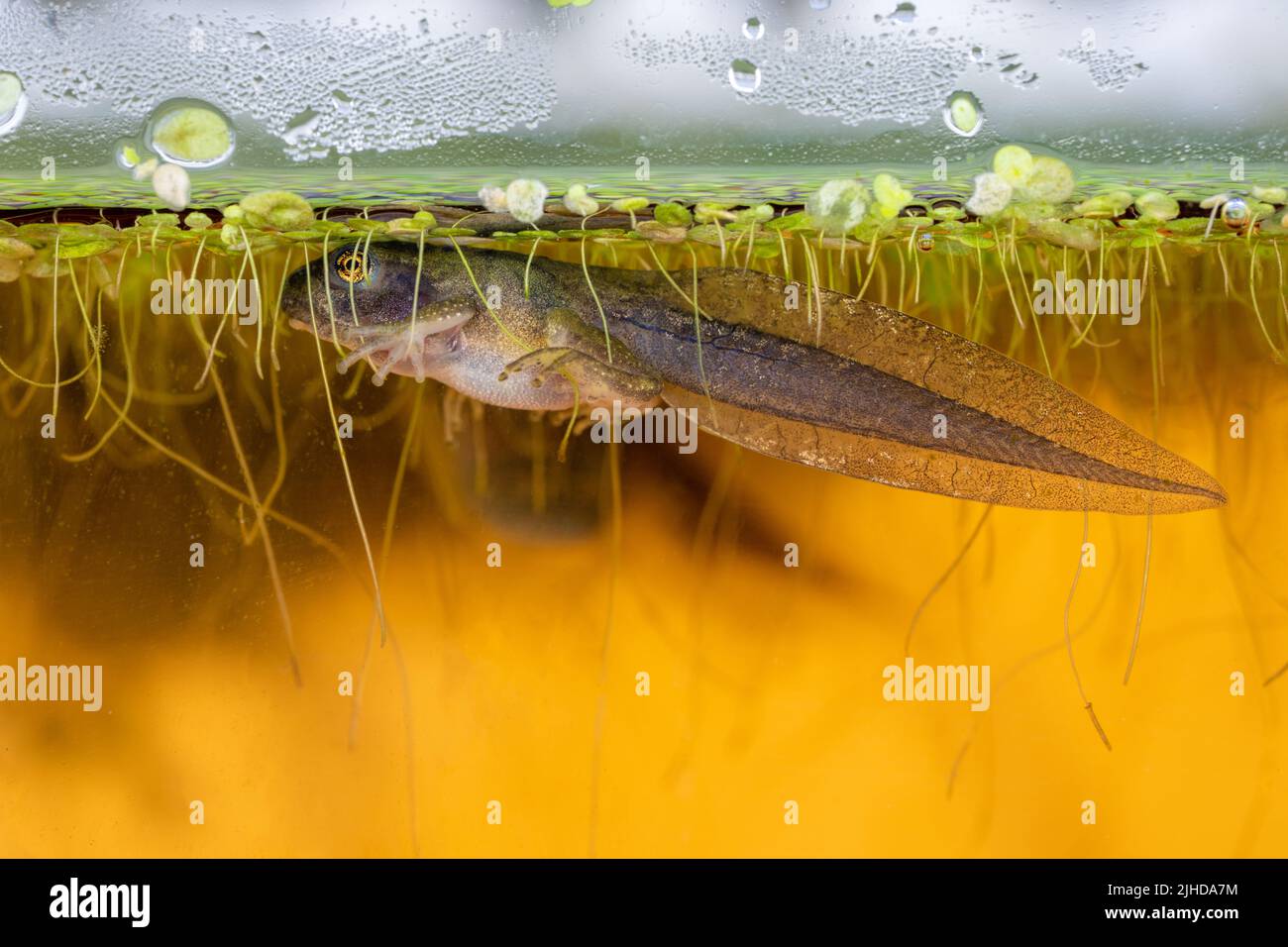 Issaquah, WA, USA. Pacific Tree Frog froglet with four legs, still needing to absorb its tail, eating duckweed in an aquarium Stock Photohttps://www.alamy.com/image-license-details/?v=1https://www.alamy.com/issaquah-wa-usa-pacific-tree-frog-froglet-with-four-legs-still-needing-to-absorb-its-tail-eating-duckweed-in-an-aquarium-image475422520.html
Issaquah, WA, USA. Pacific Tree Frog froglet with four legs, still needing to absorb its tail, eating duckweed in an aquarium Stock Photohttps://www.alamy.com/image-license-details/?v=1https://www.alamy.com/issaquah-wa-usa-pacific-tree-frog-froglet-with-four-legs-still-needing-to-absorb-its-tail-eating-duckweed-in-an-aquarium-image475422520.htmlRF2JHDA7M–Issaquah, WA, USA. Pacific Tree Frog froglet with four legs, still needing to absorb its tail, eating duckweed in an aquarium
 Issaquah, WA, USA. Pacific Tree Frog froglet with four legs, still needing to absorb its tail, eating duckweed in an aquarium Stock Photohttps://www.alamy.com/image-license-details/?v=1https://www.alamy.com/issaquah-wa-usa-pacific-tree-frog-froglet-with-four-legs-still-needing-to-absorb-its-tail-eating-duckweed-in-an-aquarium-image475422523.html
Issaquah, WA, USA. Pacific Tree Frog froglet with four legs, still needing to absorb its tail, eating duckweed in an aquarium Stock Photohttps://www.alamy.com/image-license-details/?v=1https://www.alamy.com/issaquah-wa-usa-pacific-tree-frog-froglet-with-four-legs-still-needing-to-absorb-its-tail-eating-duckweed-in-an-aquarium-image475422523.htmlRF2JHDA7R–Issaquah, WA, USA. Pacific Tree Frog froglet with four legs, still needing to absorb its tail, eating duckweed in an aquarium
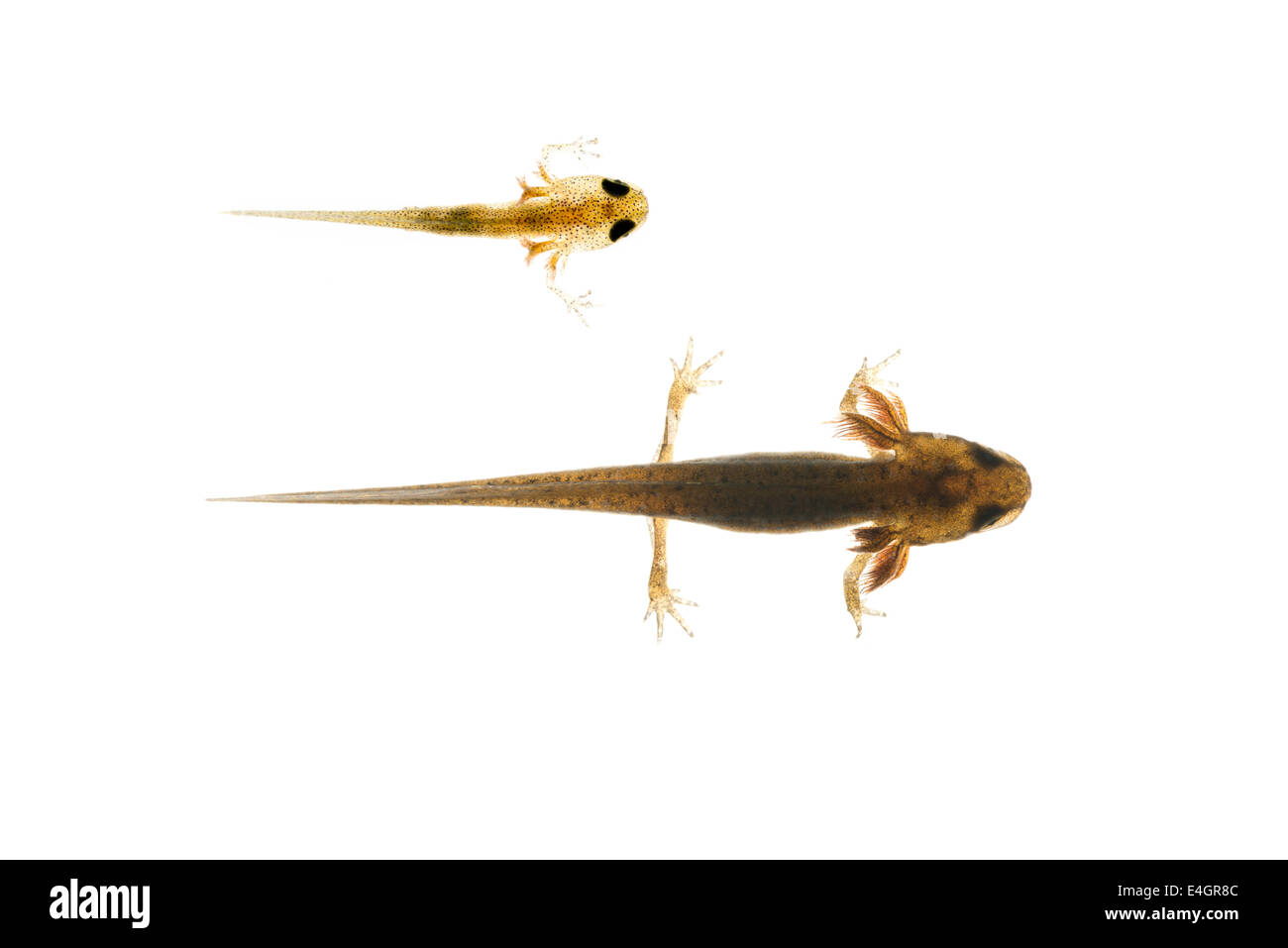 common smooth newt advanced larvae legs developing with external feathery gills will leave pond late summer or autumn 27 mm long Stock Photohttps://www.alamy.com/image-license-details/?v=1https://www.alamy.com/stock-photo-common-smooth-newt-advanced-larvae-legs-developing-with-external-feathery-71669596.html
common smooth newt advanced larvae legs developing with external feathery gills will leave pond late summer or autumn 27 mm long Stock Photohttps://www.alamy.com/image-license-details/?v=1https://www.alamy.com/stock-photo-common-smooth-newt-advanced-larvae-legs-developing-with-external-feathery-71669596.htmlRME4GR8C–common smooth newt advanced larvae legs developing with external feathery gills will leave pond late summer or autumn 27 mm long
 Issaquah, WA, USA. Pacific Tree Frog froglet with four legs, still needing to absorb its tail, eating duckweed in an aquarium Stock Photohttps://www.alamy.com/image-license-details/?v=1https://www.alamy.com/issaquah-wa-usa-pacific-tree-frog-froglet-with-four-legs-still-needing-to-absorb-its-tail-eating-duckweed-in-an-aquarium-image475422527.html
Issaquah, WA, USA. Pacific Tree Frog froglet with four legs, still needing to absorb its tail, eating duckweed in an aquarium Stock Photohttps://www.alamy.com/image-license-details/?v=1https://www.alamy.com/issaquah-wa-usa-pacific-tree-frog-froglet-with-four-legs-still-needing-to-absorb-its-tail-eating-duckweed-in-an-aquarium-image475422527.htmlRF2JHDA7Y–Issaquah, WA, USA. Pacific Tree Frog froglet with four legs, still needing to absorb its tail, eating duckweed in an aquarium
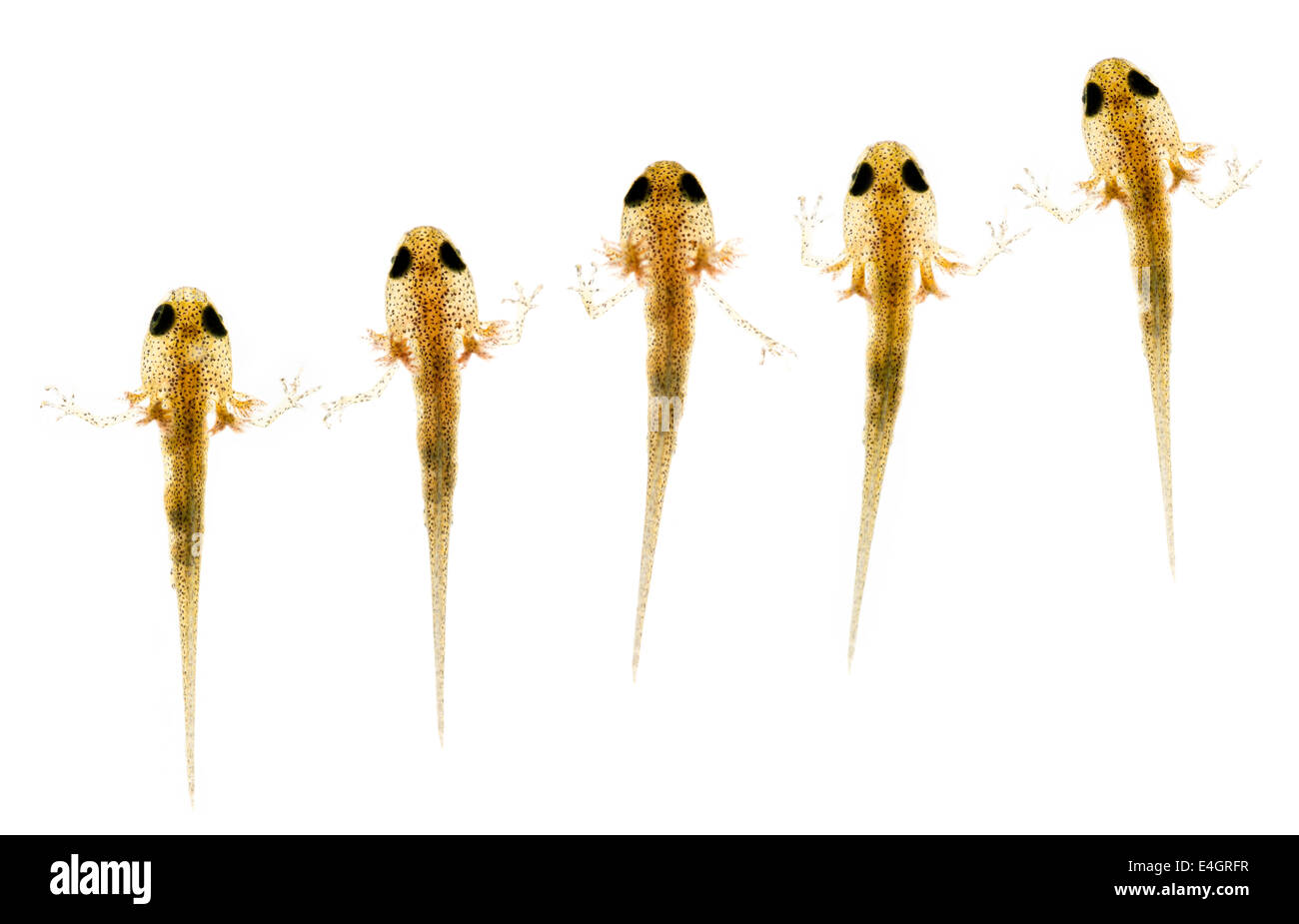 common smooth newt young larvae forelegs developing with external feathery gills will leave pond late summer or autumn Stock Photohttps://www.alamy.com/image-license-details/?v=1https://www.alamy.com/stock-photo-common-smooth-newt-young-larvae-forelegs-developing-with-external-71669803.html
common smooth newt young larvae forelegs developing with external feathery gills will leave pond late summer or autumn Stock Photohttps://www.alamy.com/image-license-details/?v=1https://www.alamy.com/stock-photo-common-smooth-newt-young-larvae-forelegs-developing-with-external-71669803.htmlRME4GRFR–common smooth newt young larvae forelegs developing with external feathery gills will leave pond late summer or autumn
 Issaquah, WA, USA. Pacific Tree Frog froglet with four legs, still needing to absorb its tail, eating duckweed in an aquarium Stock Photohttps://www.alamy.com/image-license-details/?v=1https://www.alamy.com/issaquah-wa-usa-pacific-tree-frog-froglet-with-four-legs-still-needing-to-absorb-its-tail-eating-duckweed-in-an-aquarium-image475422524.html
Issaquah, WA, USA. Pacific Tree Frog froglet with four legs, still needing to absorb its tail, eating duckweed in an aquarium Stock Photohttps://www.alamy.com/image-license-details/?v=1https://www.alamy.com/issaquah-wa-usa-pacific-tree-frog-froglet-with-four-legs-still-needing-to-absorb-its-tail-eating-duckweed-in-an-aquarium-image475422524.htmlRF2JHDA7T–Issaquah, WA, USA. Pacific Tree Frog froglet with four legs, still needing to absorb its tail, eating duckweed in an aquarium
 Issaquah, WA, USA. Pacific Tree Frog froglet with four legs, still needing to absorb its tail, eating duckweed in an aquarium Stock Photohttps://www.alamy.com/image-license-details/?v=1https://www.alamy.com/issaquah-wa-usa-pacific-tree-frog-froglet-with-four-legs-still-needing-to-absorb-its-tail-eating-duckweed-in-an-aquarium-image475422458.html
Issaquah, WA, USA. Pacific Tree Frog froglet with four legs, still needing to absorb its tail, eating duckweed in an aquarium Stock Photohttps://www.alamy.com/image-license-details/?v=1https://www.alamy.com/issaquah-wa-usa-pacific-tree-frog-froglet-with-four-legs-still-needing-to-absorb-its-tail-eating-duckweed-in-an-aquarium-image475422458.htmlRF2JHDA5E–Issaquah, WA, USA. Pacific Tree Frog froglet with four legs, still needing to absorb its tail, eating duckweed in an aquarium
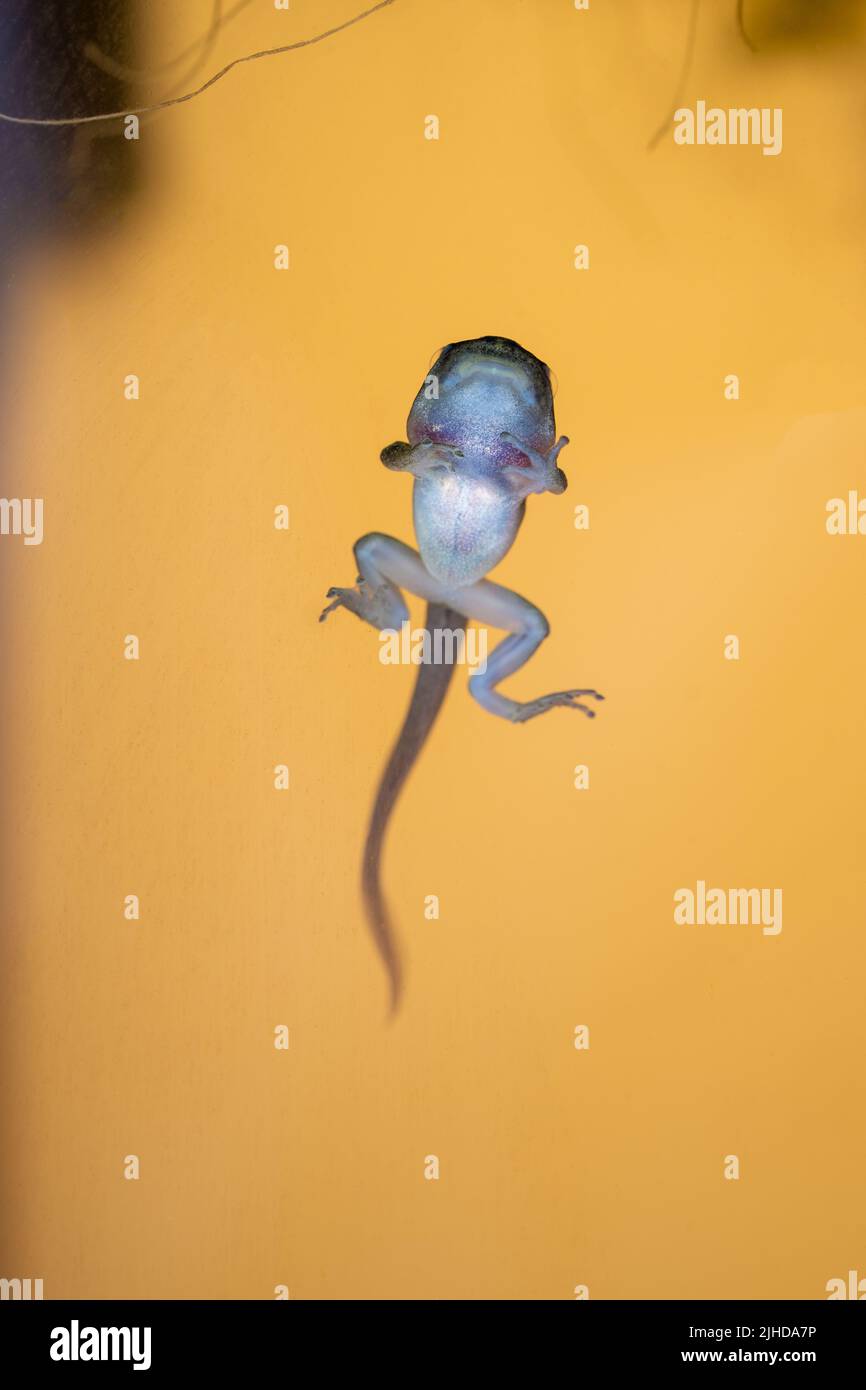 Issaquah, WA, USA. Pacific Tree Frog froglet with four legs, still needing to absorb its tail, seen from underneath in an aquarium Stock Photohttps://www.alamy.com/image-license-details/?v=1https://www.alamy.com/issaquah-wa-usa-pacific-tree-frog-froglet-with-four-legs-still-needing-to-absorb-its-tail-seen-from-underneath-in-an-aquarium-image475422522.html
Issaquah, WA, USA. Pacific Tree Frog froglet with four legs, still needing to absorb its tail, seen from underneath in an aquarium Stock Photohttps://www.alamy.com/image-license-details/?v=1https://www.alamy.com/issaquah-wa-usa-pacific-tree-frog-froglet-with-four-legs-still-needing-to-absorb-its-tail-seen-from-underneath-in-an-aquarium-image475422522.htmlRF2JHDA7P–Issaquah, WA, USA. Pacific Tree Frog froglet with four legs, still needing to absorb its tail, seen from underneath in an aquarium
 Issaquah, WA, USA. Pacific Tree Frog froglet, still needing to absorb its tail, swimming in an aquarium eating duckweed. Stock Photohttps://www.alamy.com/image-license-details/?v=1https://www.alamy.com/issaquah-wa-usa-pacific-tree-frog-froglet-still-needing-to-absorb-its-tail-swimming-in-an-aquarium-eating-duckweed-image475422580.html
Issaquah, WA, USA. Pacific Tree Frog froglet, still needing to absorb its tail, swimming in an aquarium eating duckweed. Stock Photohttps://www.alamy.com/image-license-details/?v=1https://www.alamy.com/issaquah-wa-usa-pacific-tree-frog-froglet-still-needing-to-absorb-its-tail-swimming-in-an-aquarium-eating-duckweed-image475422580.htmlRF2JHDA9T–Issaquah, WA, USA. Pacific Tree Frog froglet, still needing to absorb its tail, swimming in an aquarium eating duckweed.
 Issaquah, WA, USA. Pacific Tree Frog froglet, still needing to absorb its tail, swimming in an aquarium eating duckweed. Stock Photohttps://www.alamy.com/image-license-details/?v=1https://www.alamy.com/issaquah-wa-usa-pacific-tree-frog-froglet-still-needing-to-absorb-its-tail-swimming-in-an-aquarium-eating-duckweed-image475422571.html
Issaquah, WA, USA. Pacific Tree Frog froglet, still needing to absorb its tail, swimming in an aquarium eating duckweed. Stock Photohttps://www.alamy.com/image-license-details/?v=1https://www.alamy.com/issaquah-wa-usa-pacific-tree-frog-froglet-still-needing-to-absorb-its-tail-swimming-in-an-aquarium-eating-duckweed-image475422571.htmlRF2JHDA9F–Issaquah, WA, USA. Pacific Tree Frog froglet, still needing to absorb its tail, swimming in an aquarium eating duckweed.
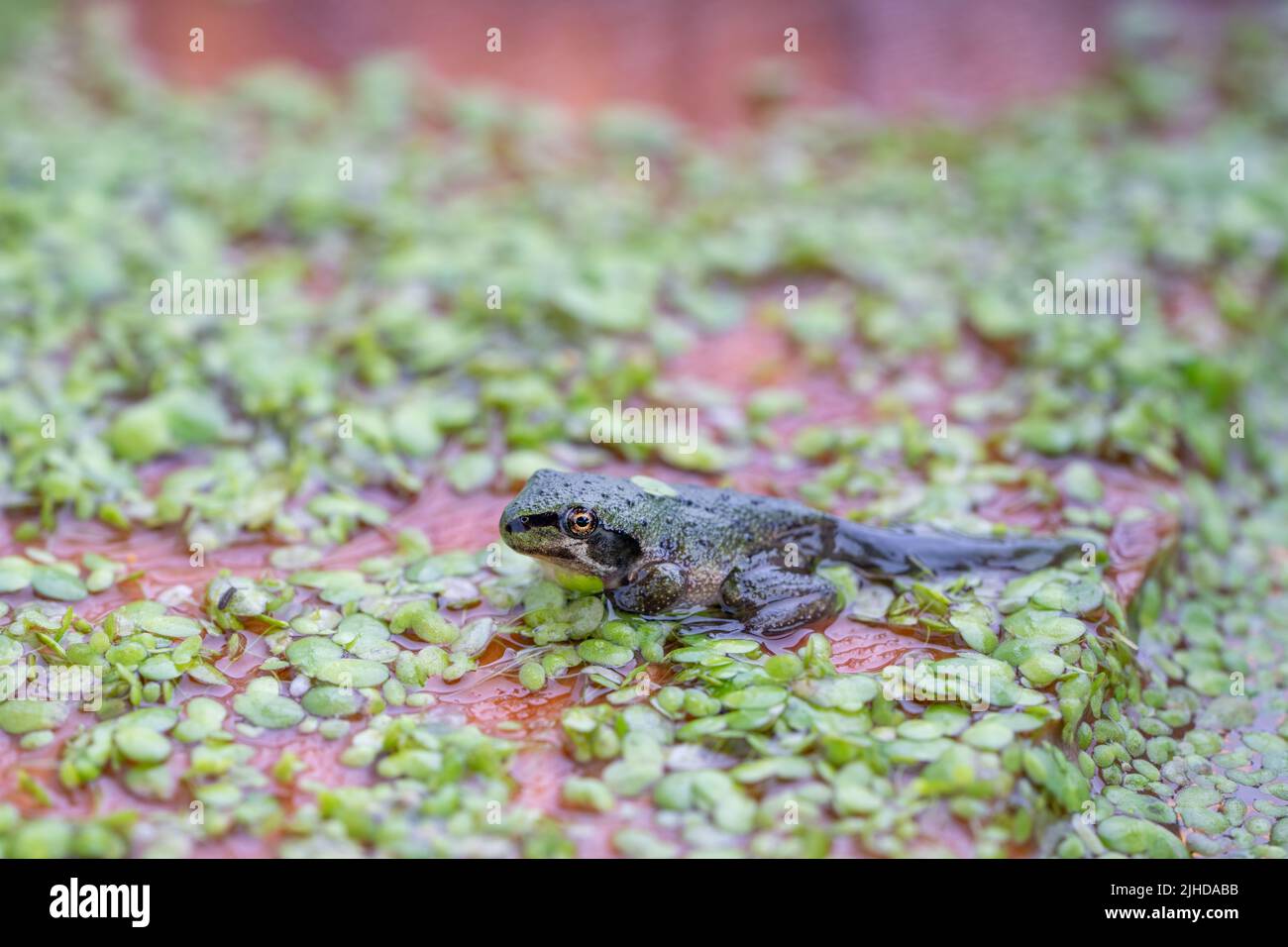 Issaquah, Washington, USA. Pacific Tree Frog froglet resting on a board covered with duckweed in an aquarium. It is going through metamorphosis Stock Photohttps://www.alamy.com/image-license-details/?v=1https://www.alamy.com/issaquah-washington-usa-pacific-tree-frog-froglet-resting-on-a-board-covered-with-duckweed-in-an-aquarium-it-is-going-through-metamorphosis-image475422623.html
Issaquah, Washington, USA. Pacific Tree Frog froglet resting on a board covered with duckweed in an aquarium. It is going through metamorphosis Stock Photohttps://www.alamy.com/image-license-details/?v=1https://www.alamy.com/issaquah-washington-usa-pacific-tree-frog-froglet-resting-on-a-board-covered-with-duckweed-in-an-aquarium-it-is-going-through-metamorphosis-image475422623.htmlRF2JHDABB–Issaquah, Washington, USA. Pacific Tree Frog froglet resting on a board covered with duckweed in an aquarium. It is going through metamorphosis
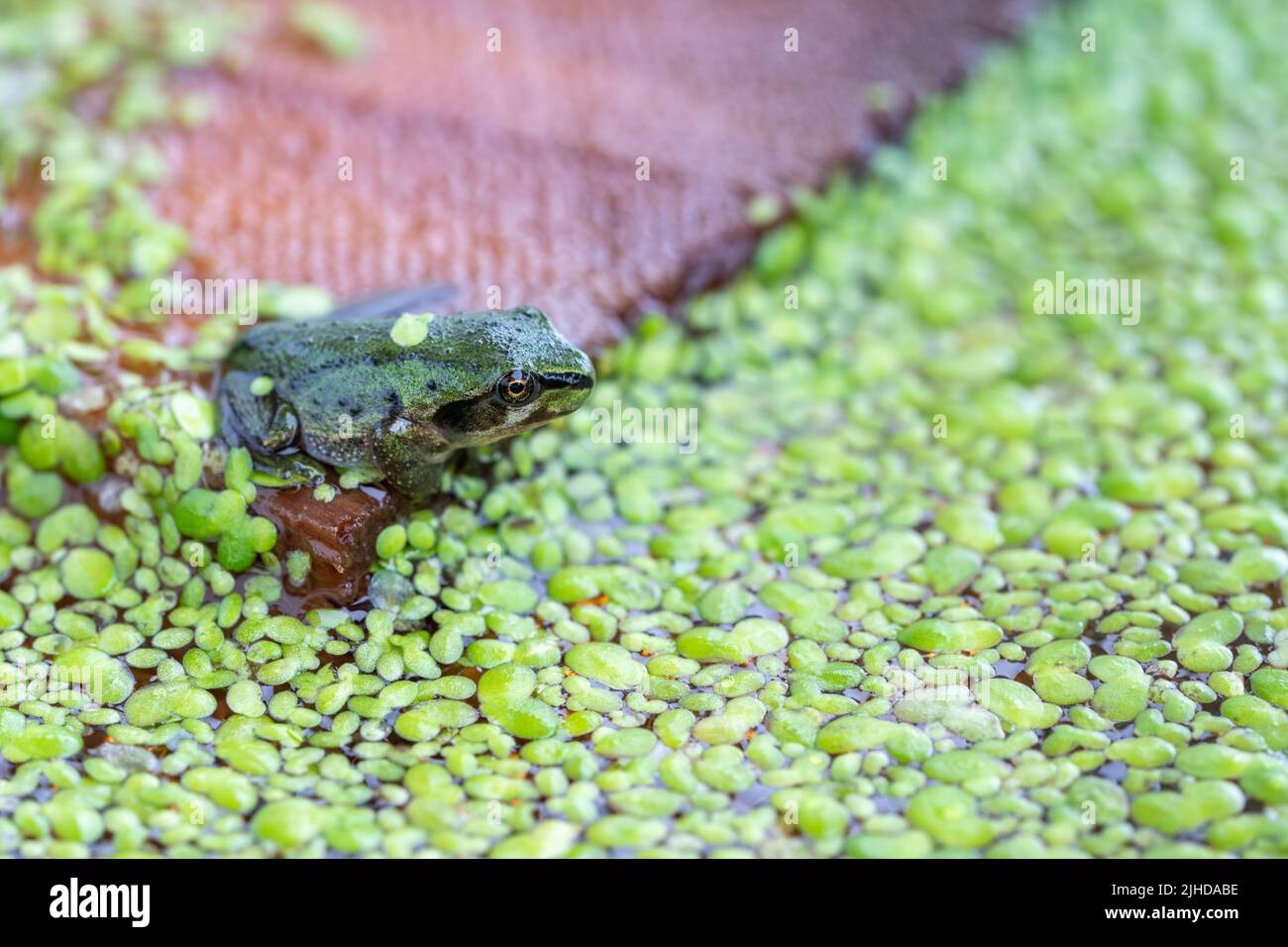 Issaquah, Washington, USA. Pacific Tree Frog froglets resting on a board covered with duckweed in an aquarium. It is going through metamorphosis Stock Photohttps://www.alamy.com/image-license-details/?v=1https://www.alamy.com/issaquah-washington-usa-pacific-tree-frog-froglets-resting-on-a-board-covered-with-duckweed-in-an-aquarium-it-is-going-through-metamorphosis-image475422626.html
Issaquah, Washington, USA. Pacific Tree Frog froglets resting on a board covered with duckweed in an aquarium. It is going through metamorphosis Stock Photohttps://www.alamy.com/image-license-details/?v=1https://www.alamy.com/issaquah-washington-usa-pacific-tree-frog-froglets-resting-on-a-board-covered-with-duckweed-in-an-aquarium-it-is-going-through-metamorphosis-image475422626.htmlRF2JHDABE–Issaquah, Washington, USA. Pacific Tree Frog froglets resting on a board covered with duckweed in an aquarium. It is going through metamorphosis
 Issaquah, Washington, USA. Pacific Tree Frog froglet resting on a board covered with duckweed in an aquarium. It is going through metamorphosis Stock Photohttps://www.alamy.com/image-license-details/?v=1https://www.alamy.com/issaquah-washington-usa-pacific-tree-frog-froglet-resting-on-a-board-covered-with-duckweed-in-an-aquarium-it-is-going-through-metamorphosis-image475422615.html
Issaquah, Washington, USA. Pacific Tree Frog froglet resting on a board covered with duckweed in an aquarium. It is going through metamorphosis Stock Photohttps://www.alamy.com/image-license-details/?v=1https://www.alamy.com/issaquah-washington-usa-pacific-tree-frog-froglet-resting-on-a-board-covered-with-duckweed-in-an-aquarium-it-is-going-through-metamorphosis-image475422615.htmlRF2JHDAB3–Issaquah, Washington, USA. Pacific Tree Frog froglet resting on a board covered with duckweed in an aquarium. It is going through metamorphosis
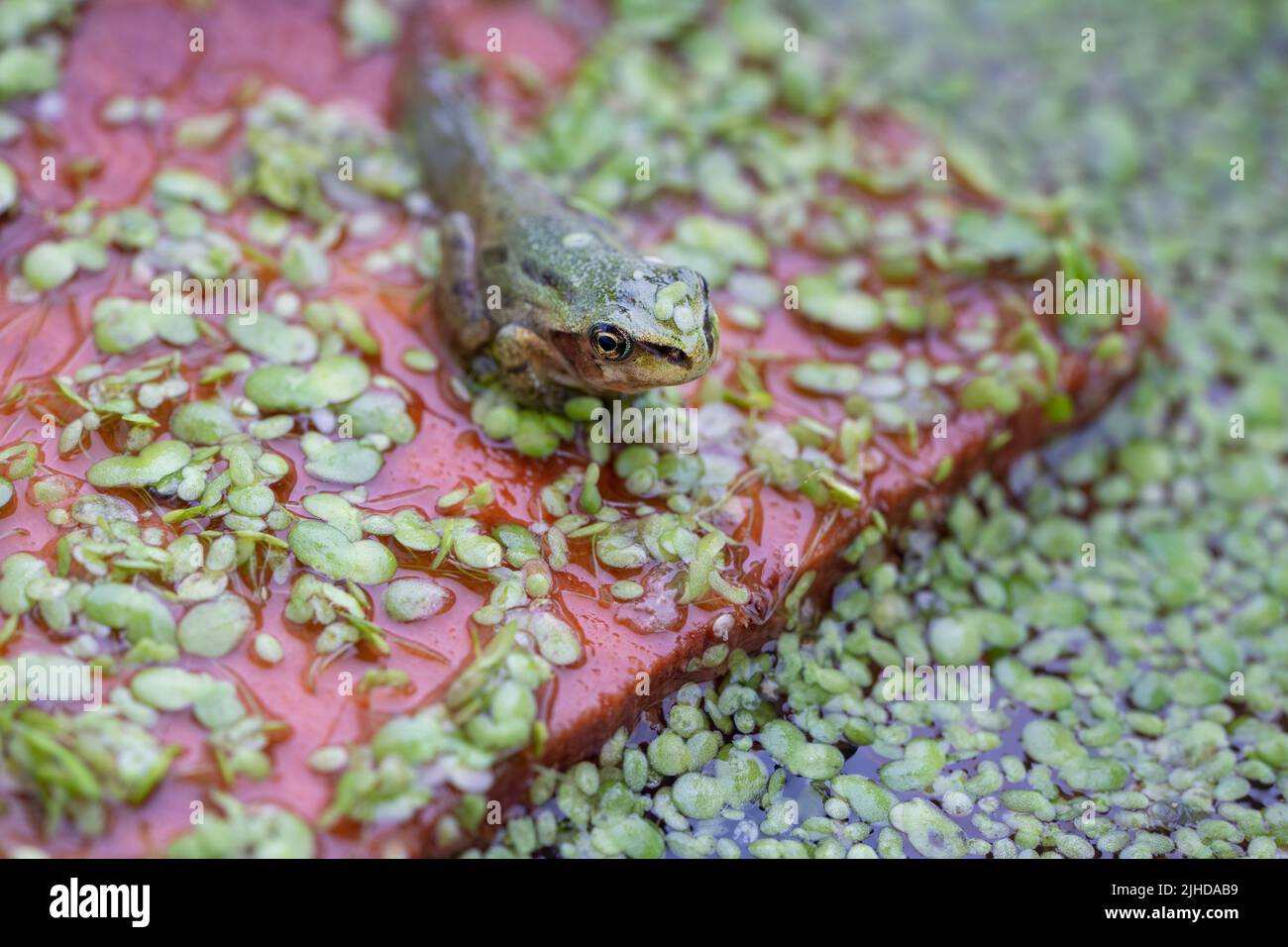 Issaquah, Washington, USA. Pacific Tree Frog froglet resting on a board covered with duckweed in an aquarium. It is going through metamorphosis Stock Photohttps://www.alamy.com/image-license-details/?v=1https://www.alamy.com/issaquah-washington-usa-pacific-tree-frog-froglet-resting-on-a-board-covered-with-duckweed-in-an-aquarium-it-is-going-through-metamorphosis-image475422621.html
Issaquah, Washington, USA. Pacific Tree Frog froglet resting on a board covered with duckweed in an aquarium. It is going through metamorphosis Stock Photohttps://www.alamy.com/image-license-details/?v=1https://www.alamy.com/issaquah-washington-usa-pacific-tree-frog-froglet-resting-on-a-board-covered-with-duckweed-in-an-aquarium-it-is-going-through-metamorphosis-image475422621.htmlRF2JHDAB9–Issaquah, Washington, USA. Pacific Tree Frog froglet resting on a board covered with duckweed in an aquarium. It is going through metamorphosis
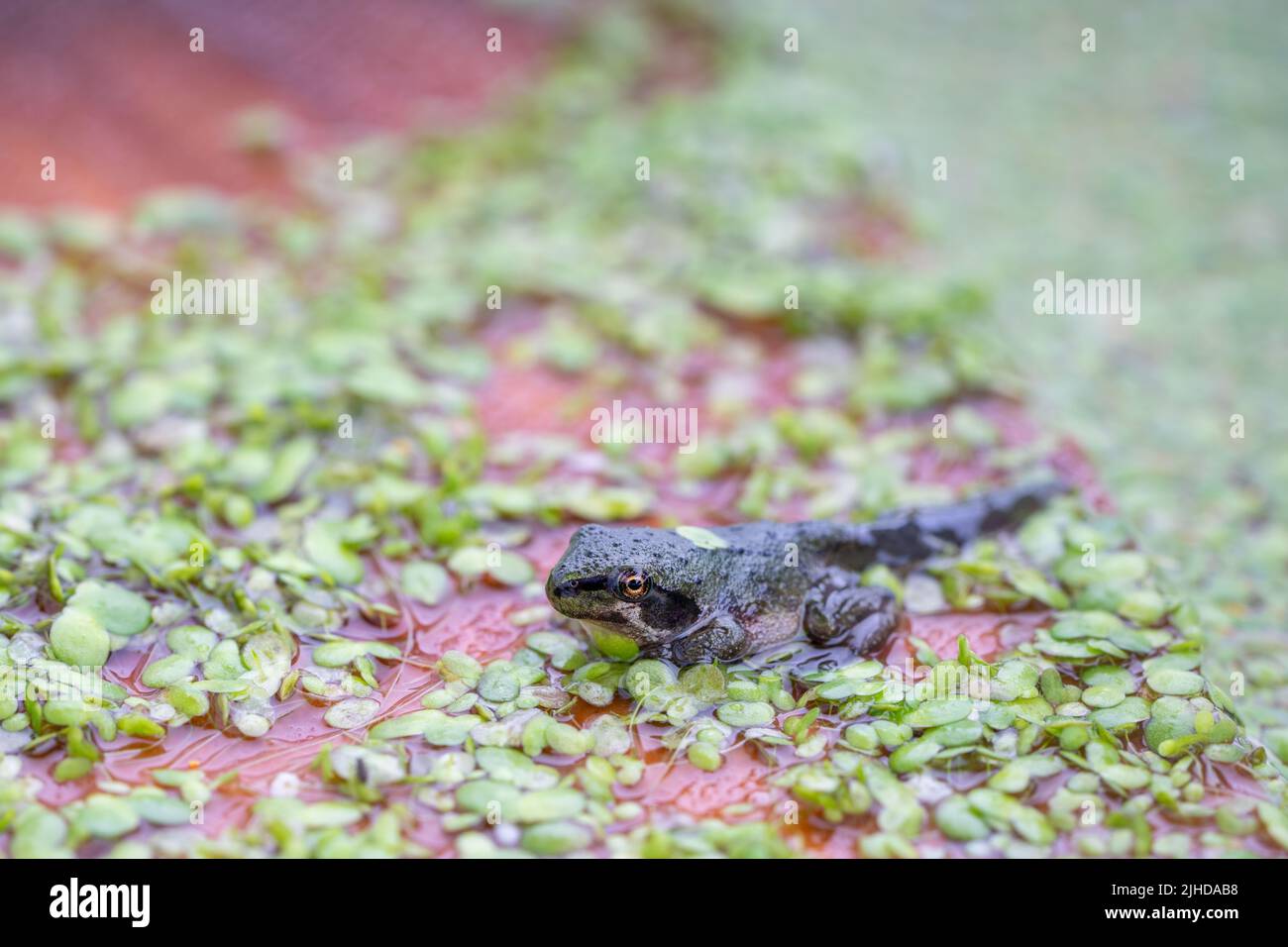 Issaquah, Washington, USA. Pacific Tree Frog froglet resting on a board covered with duckweed in an aquarium. It is going through metamorphosis Stock Photohttps://www.alamy.com/image-license-details/?v=1https://www.alamy.com/issaquah-washington-usa-pacific-tree-frog-froglet-resting-on-a-board-covered-with-duckweed-in-an-aquarium-it-is-going-through-metamorphosis-image475422620.html
Issaquah, Washington, USA. Pacific Tree Frog froglet resting on a board covered with duckweed in an aquarium. It is going through metamorphosis Stock Photohttps://www.alamy.com/image-license-details/?v=1https://www.alamy.com/issaquah-washington-usa-pacific-tree-frog-froglet-resting-on-a-board-covered-with-duckweed-in-an-aquarium-it-is-going-through-metamorphosis-image475422620.htmlRF2JHDAB8–Issaquah, Washington, USA. Pacific Tree Frog froglet resting on a board covered with duckweed in an aquarium. It is going through metamorphosis
 Issaquah, Washington, USA. Pacific Tree Frog froglet resting on a board covered with duckweed in an aquarium. It is going through metamorphosis Stock Photohttps://www.alamy.com/image-license-details/?v=1https://www.alamy.com/issaquah-washington-usa-pacific-tree-frog-froglet-resting-on-a-board-covered-with-duckweed-in-an-aquarium-it-is-going-through-metamorphosis-image475422616.html
Issaquah, Washington, USA. Pacific Tree Frog froglet resting on a board covered with duckweed in an aquarium. It is going through metamorphosis Stock Photohttps://www.alamy.com/image-license-details/?v=1https://www.alamy.com/issaquah-washington-usa-pacific-tree-frog-froglet-resting-on-a-board-covered-with-duckweed-in-an-aquarium-it-is-going-through-metamorphosis-image475422616.htmlRF2JHDAB4–Issaquah, Washington, USA. Pacific Tree Frog froglet resting on a board covered with duckweed in an aquarium. It is going through metamorphosis
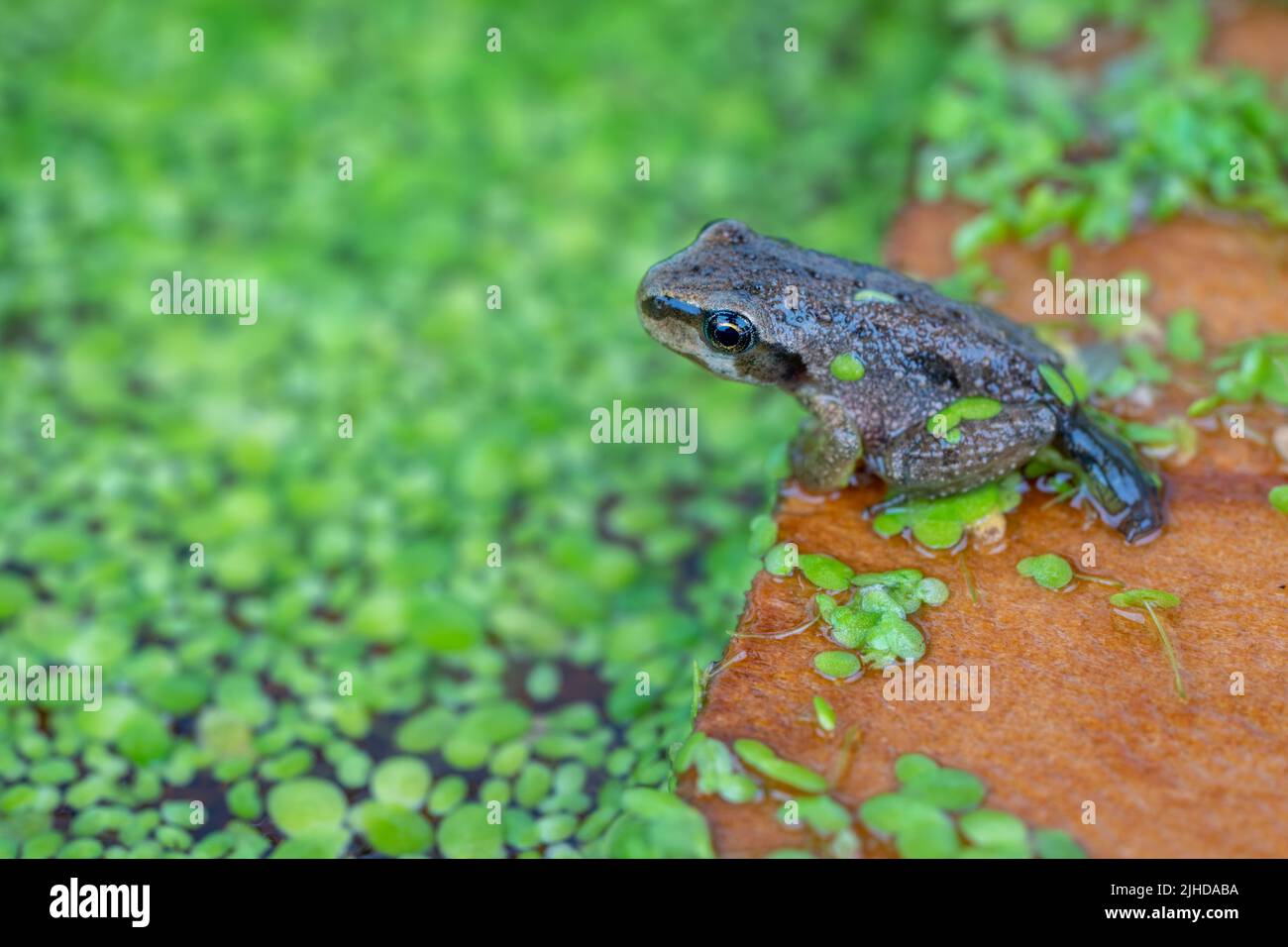 Issaquah, Washington, USA. Pacific Tree Frog froglet resting on a board covered with duckweed in an aquarium. It is going through metamorphosis Stock Photohttps://www.alamy.com/image-license-details/?v=1https://www.alamy.com/issaquah-washington-usa-pacific-tree-frog-froglet-resting-on-a-board-covered-with-duckweed-in-an-aquarium-it-is-going-through-metamorphosis-image475422622.html
Issaquah, Washington, USA. Pacific Tree Frog froglet resting on a board covered with duckweed in an aquarium. It is going through metamorphosis Stock Photohttps://www.alamy.com/image-license-details/?v=1https://www.alamy.com/issaquah-washington-usa-pacific-tree-frog-froglet-resting-on-a-board-covered-with-duckweed-in-an-aquarium-it-is-going-through-metamorphosis-image475422622.htmlRF2JHDABA–Issaquah, Washington, USA. Pacific Tree Frog froglet resting on a board covered with duckweed in an aquarium. It is going through metamorphosis
 Issaquah, Washington, USA. Pacific Tree Frog froglet resting on a board covered with duckweed in an aquarium. It is going through metamorphosis Stock Photohttps://www.alamy.com/image-license-details/?v=1https://www.alamy.com/issaquah-washington-usa-pacific-tree-frog-froglet-resting-on-a-board-covered-with-duckweed-in-an-aquarium-it-is-going-through-metamorphosis-image475422587.html
Issaquah, Washington, USA. Pacific Tree Frog froglet resting on a board covered with duckweed in an aquarium. It is going through metamorphosis Stock Photohttps://www.alamy.com/image-license-details/?v=1https://www.alamy.com/issaquah-washington-usa-pacific-tree-frog-froglet-resting-on-a-board-covered-with-duckweed-in-an-aquarium-it-is-going-through-metamorphosis-image475422587.htmlRF2JHDAA3–Issaquah, Washington, USA. Pacific Tree Frog froglet resting on a board covered with duckweed in an aquarium. It is going through metamorphosis
 Issaquah, Washington, USA. Pacific Tree Frog froglet resting on a board covered with duckweed in an aquarium. It is going through metamorphosis Stock Photohttps://www.alamy.com/image-license-details/?v=1https://www.alamy.com/issaquah-washington-usa-pacific-tree-frog-froglet-resting-on-a-board-covered-with-duckweed-in-an-aquarium-it-is-going-through-metamorphosis-image475422586.html
Issaquah, Washington, USA. Pacific Tree Frog froglet resting on a board covered with duckweed in an aquarium. It is going through metamorphosis Stock Photohttps://www.alamy.com/image-license-details/?v=1https://www.alamy.com/issaquah-washington-usa-pacific-tree-frog-froglet-resting-on-a-board-covered-with-duckweed-in-an-aquarium-it-is-going-through-metamorphosis-image475422586.htmlRF2JHDAA2–Issaquah, Washington, USA. Pacific Tree Frog froglet resting on a board covered with duckweed in an aquarium. It is going through metamorphosis
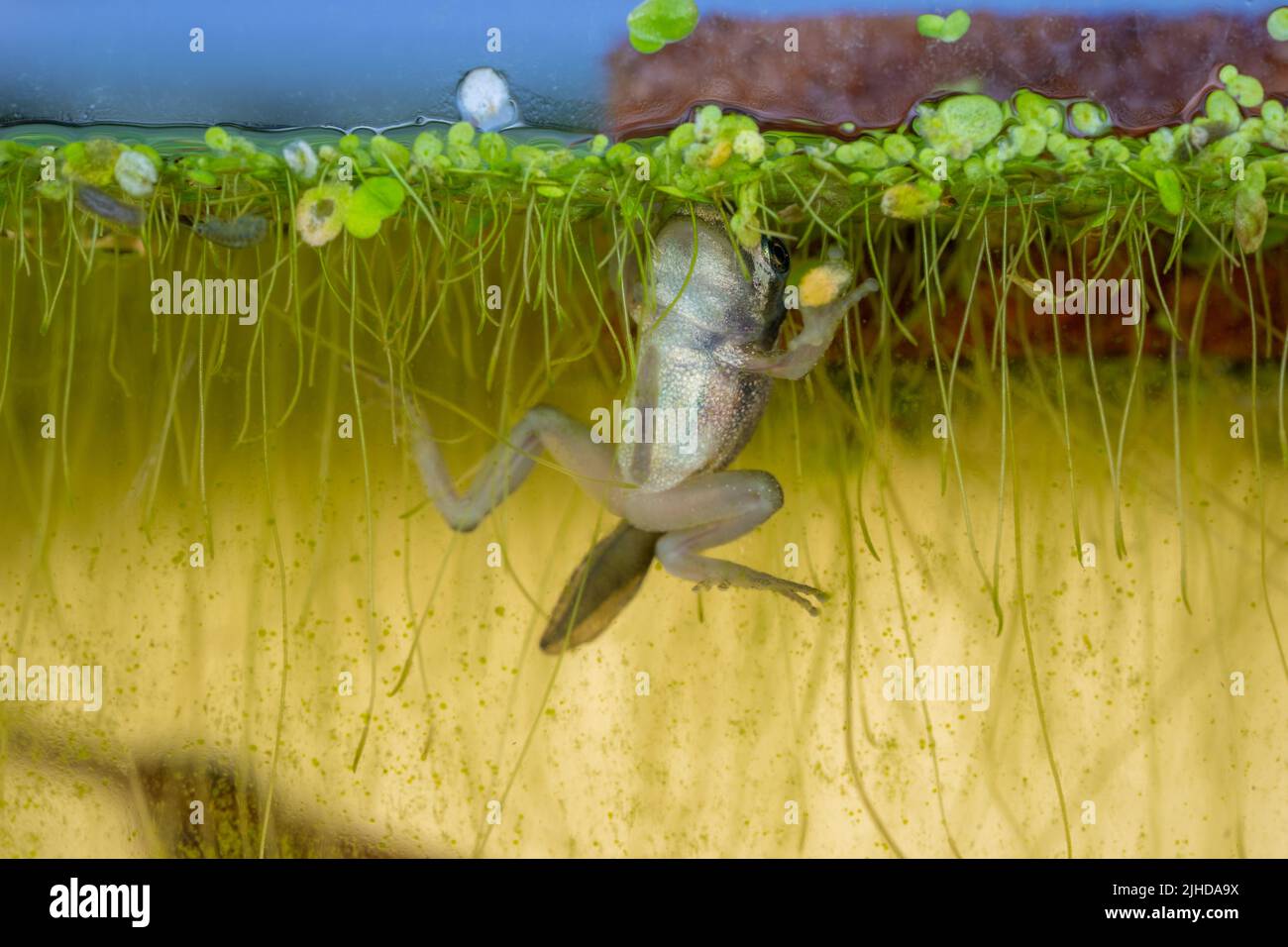 Issaquah, Washington, USA. Pacific Tree Frog tadpoles eating greenery in an aquarium. Stock Photohttps://www.alamy.com/image-license-details/?v=1https://www.alamy.com/issaquah-washington-usa-pacific-tree-frog-tadpoles-eating-greenery-in-an-aquarium-image475422582.html
Issaquah, Washington, USA. Pacific Tree Frog tadpoles eating greenery in an aquarium. Stock Photohttps://www.alamy.com/image-license-details/?v=1https://www.alamy.com/issaquah-washington-usa-pacific-tree-frog-tadpoles-eating-greenery-in-an-aquarium-image475422582.htmlRF2JHDA9X–Issaquah, Washington, USA. Pacific Tree Frog tadpoles eating greenery in an aquarium.
 Issaquah, Washington, USA. Pacific Tree Frog froglet trying to reach somewhere to rest on top of the water where it can breathe air, in an aquarium. Stock Photohttps://www.alamy.com/image-license-details/?v=1https://www.alamy.com/issaquah-washington-usa-pacific-tree-frog-froglet-trying-to-reach-somewhere-to-rest-on-top-of-the-water-where-it-can-breathe-air-in-an-aquarium-image475422584.html
Issaquah, Washington, USA. Pacific Tree Frog froglet trying to reach somewhere to rest on top of the water where it can breathe air, in an aquarium. Stock Photohttps://www.alamy.com/image-license-details/?v=1https://www.alamy.com/issaquah-washington-usa-pacific-tree-frog-froglet-trying-to-reach-somewhere-to-rest-on-top-of-the-water-where-it-can-breathe-air-in-an-aquarium-image475422584.htmlRF2JHDAA0–Issaquah, Washington, USA. Pacific Tree Frog froglet trying to reach somewhere to rest on top of the water where it can breathe air, in an aquarium.
 Issaquah, Washington, USA. Pacific Tree Frog froglet trying to reach somewhere to rest on top of the water where it can breathe air, in an aquarium. Stock Photohttps://www.alamy.com/image-license-details/?v=1https://www.alamy.com/issaquah-washington-usa-pacific-tree-frog-froglet-trying-to-reach-somewhere-to-rest-on-top-of-the-water-where-it-can-breathe-air-in-an-aquarium-image475422574.html
Issaquah, Washington, USA. Pacific Tree Frog froglet trying to reach somewhere to rest on top of the water where it can breathe air, in an aquarium. Stock Photohttps://www.alamy.com/image-license-details/?v=1https://www.alamy.com/issaquah-washington-usa-pacific-tree-frog-froglet-trying-to-reach-somewhere-to-rest-on-top-of-the-water-where-it-can-breathe-air-in-an-aquarium-image475422574.htmlRF2JHDA9J–Issaquah, Washington, USA. Pacific Tree Frog froglet trying to reach somewhere to rest on top of the water where it can breathe air, in an aquarium.
 Issaquah, Washington, USA. Pacific Tree Frog froglet trying to reach somewhere to rest on top of the water where it can breathe air, in an aquarium. Stock Photohttps://www.alamy.com/image-license-details/?v=1https://www.alamy.com/issaquah-washington-usa-pacific-tree-frog-froglet-trying-to-reach-somewhere-to-rest-on-top-of-the-water-where-it-can-breathe-air-in-an-aquarium-image475422585.html
Issaquah, Washington, USA. Pacific Tree Frog froglet trying to reach somewhere to rest on top of the water where it can breathe air, in an aquarium. Stock Photohttps://www.alamy.com/image-license-details/?v=1https://www.alamy.com/issaquah-washington-usa-pacific-tree-frog-froglet-trying-to-reach-somewhere-to-rest-on-top-of-the-water-where-it-can-breathe-air-in-an-aquarium-image475422585.htmlRF2JHDAA1–Issaquah, Washington, USA. Pacific Tree Frog froglet trying to reach somewhere to rest on top of the water where it can breathe air, in an aquarium.
 Issaquah, Washington, USA. Pacific Tree Frog froglet trying to reach somewhere to rest on top of the water where it can breathe air, in an aquarium. Stock Photohttps://www.alamy.com/image-license-details/?v=1https://www.alamy.com/issaquah-washington-usa-pacific-tree-frog-froglet-trying-to-reach-somewhere-to-rest-on-top-of-the-water-where-it-can-breathe-air-in-an-aquarium-image475422583.html
Issaquah, Washington, USA. Pacific Tree Frog froglet trying to reach somewhere to rest on top of the water where it can breathe air, in an aquarium. Stock Photohttps://www.alamy.com/image-license-details/?v=1https://www.alamy.com/issaquah-washington-usa-pacific-tree-frog-froglet-trying-to-reach-somewhere-to-rest-on-top-of-the-water-where-it-can-breathe-air-in-an-aquarium-image475422583.htmlRF2JHDA9Y–Issaquah, Washington, USA. Pacific Tree Frog froglet trying to reach somewhere to rest on top of the water where it can breathe air, in an aquarium.